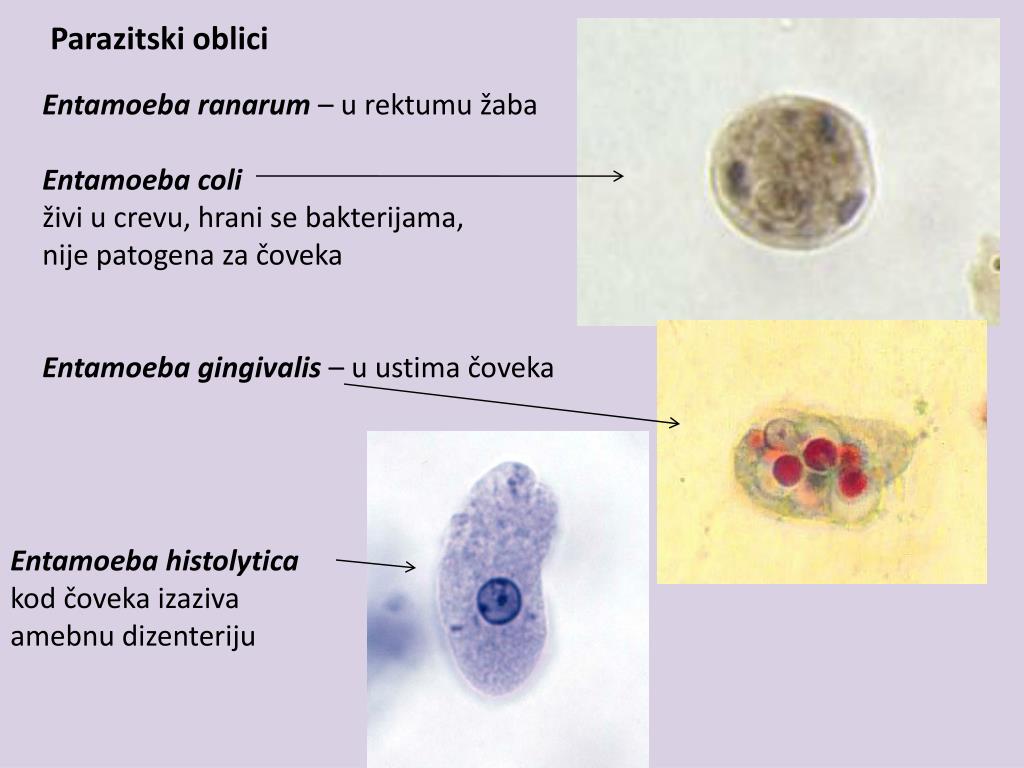Entamoeba Histolytica: A Comprehensive Guide to Amebiasis
What is Entamoeba histolytica. How is it transmitted. What are the symptoms of amebiasis. How is amebiasis diagnosed. What are the treatment options for Entamoeba histolytica infection. Can amebiasis be prevented. What are the complications of untreated amebiasis.
Understanding Entamoeba Histolytica: The Causative Agent of Amebiasis
Entamoeba histolytica is a protozoan parasite responsible for causing amebiasis, a potentially serious intestinal infection. This microscopic organism exists in two forms: the hardy cyst form, which can survive in the environment for extended periods, and the active trophozoite form, which invades and damages the intestinal lining.
The impact of E. histolytica on global health is significant. While 90% of infections remain asymptomatic, approximately 50 million people worldwide develop symptomatic amebiasis annually, resulting in an estimated 100,000 deaths. This makes E. histolytica the third leading cause of death from parasitic infections globally.
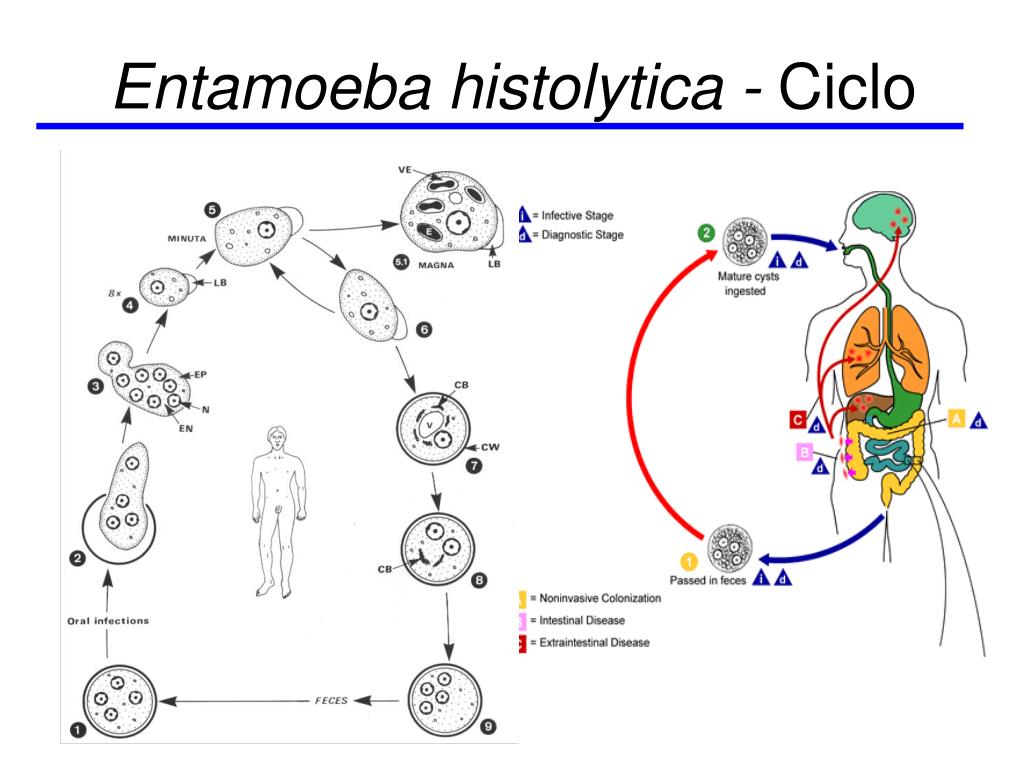
How is Entamoeba histolytica transmitted?
E. histolytica is primarily transmitted through the fecal-oral route. This occurs when individuals ingest food or water contaminated with E. histolytica cysts. Poor sanitation, inadequate hygiene practices, and contaminated water sources contribute to the spread of this parasite, particularly in areas with limited access to clean water and proper sanitation facilities.
The Global Epidemiology of Amebiasis
Amebiasis is a worldwide health concern, with a disproportionate impact on regions with lower socioeconomic conditions and inadequate public health infrastructure. Countries such as India, various African nations, Mexico, and parts of Central and South America report higher prevalence rates of E. histolytica infection.
For instance, a three-year study conducted in Bangladesh revealed that 2.2% of dysentery cases in preschool children were attributed to E. histolytica. In rural areas of Mexico, the seroprevalence of E. histolytica has been reported to be as high as 42%.
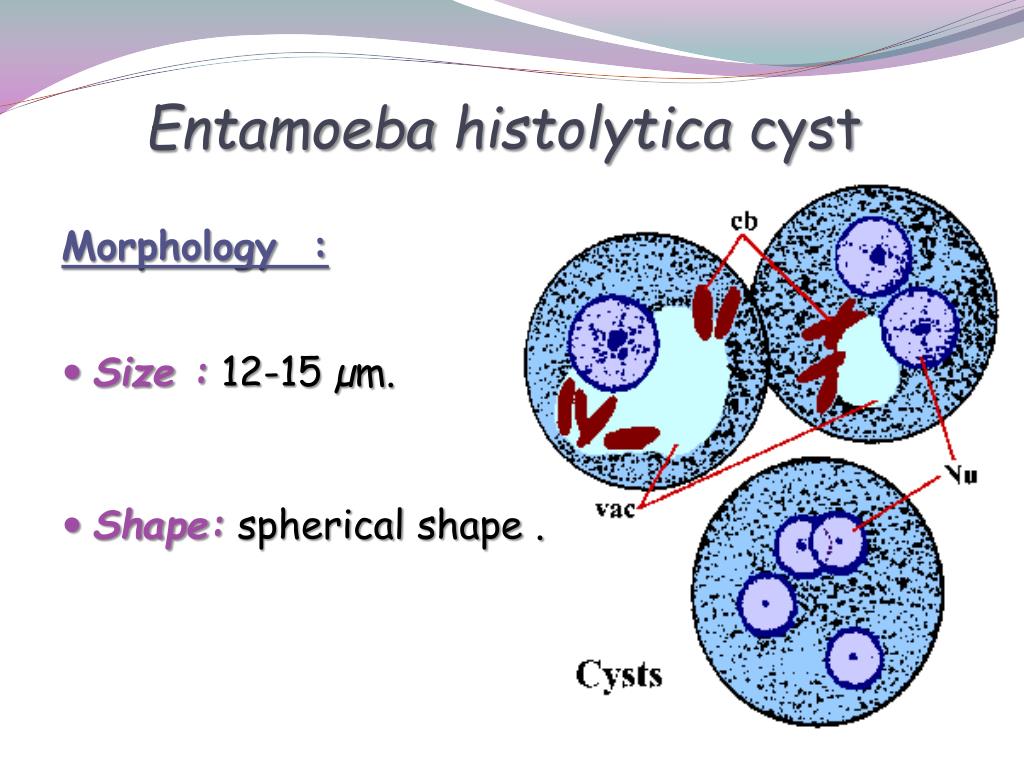
Who is at risk for Entamoeba histolytica infection?
- Residents of endemic areas with poor sanitation
- Travelers to regions with high prevalence rates
- Immigrants from endemic areas
- Individuals with compromised immune systems
- Men who have sex with men (due to potential fecal-oral transmission during sexual activities)
In developed countries like the United States, amebiasis is relatively rare, accounting for approximately 5 deaths per year. Cases in these regions are typically associated with individuals who have traveled to or immigrated from endemic areas.
The Pathophysiology of Entamoeba Histolytica Infection
The pathogenesis of E. histolytica infection is a complex process involving the interaction between the parasite and the host’s immune system. When an individual ingests E. histolytica cysts, they transform into trophozoites in the intestinal lumen. These trophozoites can then invade and penetrate the intestinal mucosa, leading to tissue destruction and inflammation.
How does Entamoeba histolytica cause damage to the intestinal lining?
The trophozoites adhere to colonic epithelial cells using a specific galactose-N-acetylgalactosamine lectin. This adherence initiates a cascade of events:
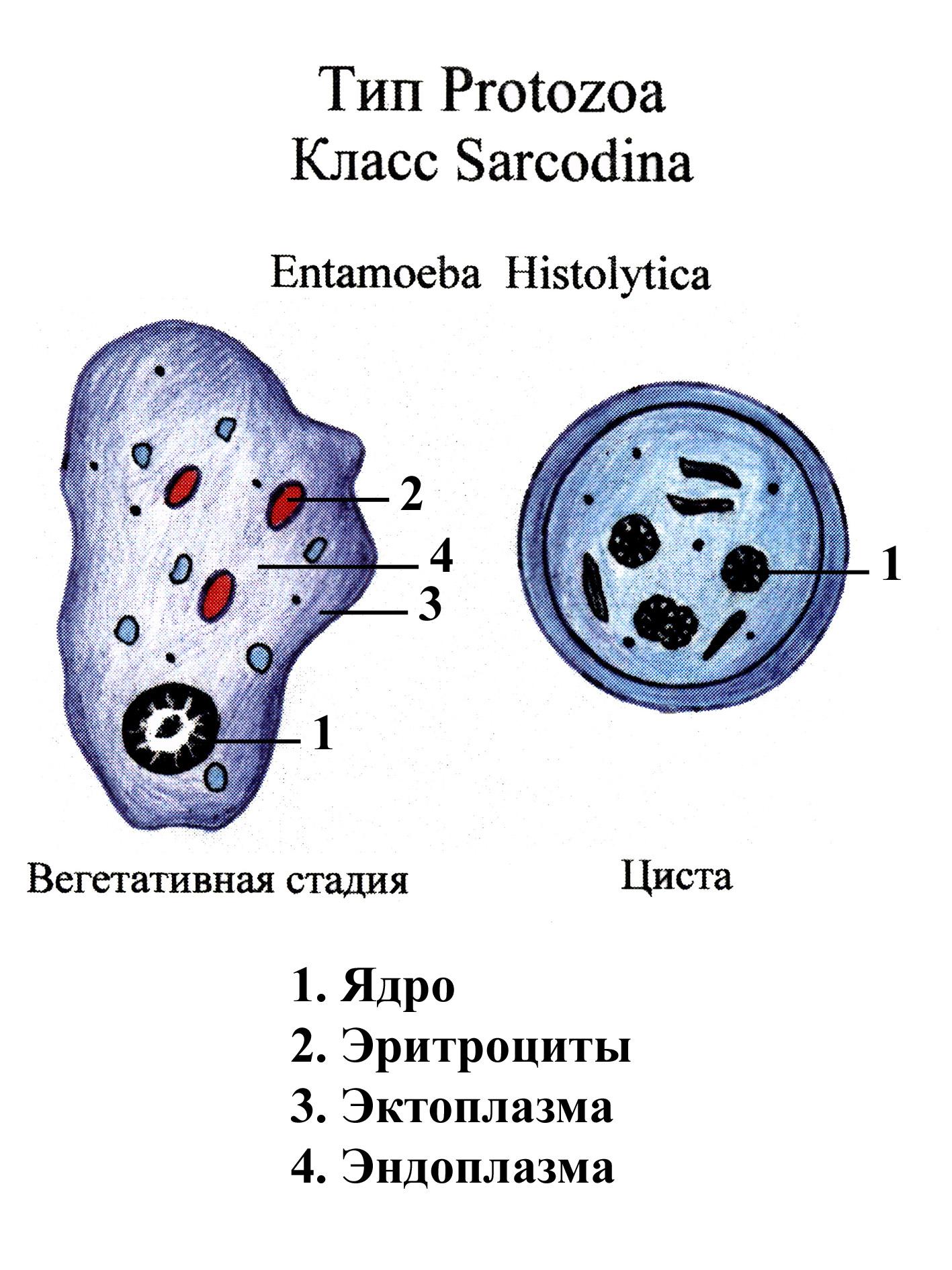
- Direct cell damage: Trophozoites cause cytolysis and apoptosis of epithelial cells.
- Inflammatory response: Damaged cells release interleukin-1α and precursor interleukin-1β.
- Cytokine production: IL-1β activates NF-κB, leading to the production of additional inflammatory mediators.
- Neutrophil and macrophage attraction: These immune cells are drawn to the site of infection.
- Amplification of damage: Neutrophils damaged by trophozoites cause further harm to colonic epithelial cells.
- Ongoing inflammation: Macrophages release TNFα and other mediators, perpetuating the inflammatory process.
Clinical Manifestations of Amebiasis
Amebiasis can present with a wide spectrum of clinical manifestations, ranging from asymptomatic colonization to severe, life-threatening disease. The most common form of symptomatic amebiasis is amoebic colitis, which typically develops 2-4 weeks after ingestion of E. histolytica cysts.
What are the symptoms of amoebic colitis?
Patients with amoebic colitis may experience:

- Abdominal pain and cramping
- Bloody diarrhea
- Tenesmus (a feeling of incomplete evacuation)
- Weight loss
- Fever (in severe cases)
In some cases, E. histolytica can spread beyond the intestinal tract, leading to extraintestinal amebiasis. The most common form of extraintestinal disease is amoebic liver abscess, which typically presents with right upper quadrant pain, fever, and hepatomegaly.
Diagnostic Approaches for Entamoeba Histolytica Infection
Accurate diagnosis of E. histolytica infection is crucial for appropriate management and to differentiate it from other causes of diarrhea or liver abscesses. Several diagnostic methods are available, each with its own advantages and limitations.
How is amebiasis diagnosed?
The following diagnostic approaches may be used:
- Microscopic examination of stool samples: This can detect cysts or trophozoites but requires expertise and may not differentiate between pathogenic E. histolytica and non-pathogenic species.
- Antigen detection tests: Enzyme immunoassays (EIA) can detect E. histolytica-specific antigens in stool samples with high sensitivity and specificity.
- Serology: Antibody detection tests are useful for diagnosing extraintestinal amebiasis but may remain positive for years after infection.
- PCR: Molecular methods can detect E. histolytica DNA in stool samples or tissue specimens with high sensitivity and specificity.
- Imaging studies: Ultrasonography, CT, or MRI can be helpful in diagnosing amoebic liver abscesses.
Treatment Strategies for Amebiasis
The treatment of amebiasis depends on the clinical presentation and the severity of the infection. A combination of drugs is often used to eradicate both intestinal and tissue infections.
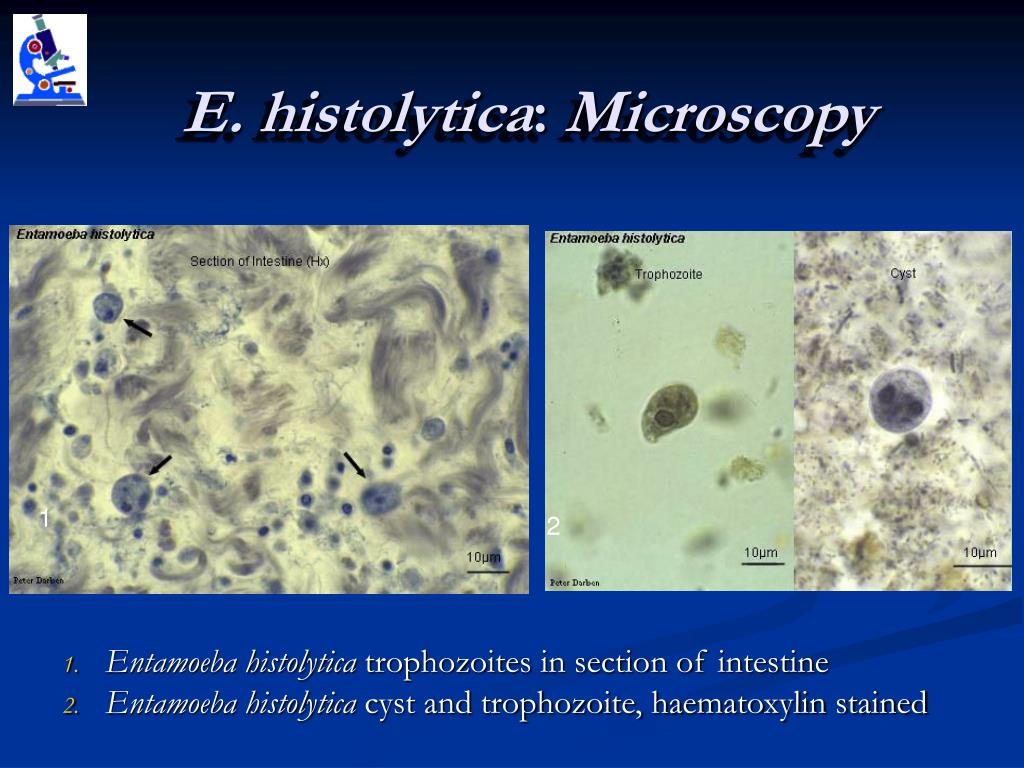
What are the treatment options for Entamoeba histolytica infection?
The standard treatment regimen typically includes:
- Metronidazole or tinidazole: These are the drugs of choice for treating invasive amebiasis, including amoebic colitis and liver abscess.
- Paromomycin or diloxanide furoate: These luminal agents are used to eradicate intestinal cyst carriage after treatment with metronidazole or tinidazole.
- Supportive care: This may include fluid and electrolyte replacement, particularly in cases of severe diarrhea.
In cases of amoebic liver abscess, percutaneous drainage may be necessary if there is no response to medical therapy or if there is a risk of rupture.
Prevention and Control of Entamoeba Histolytica Transmission
Preventing the spread of E. histolytica is crucial for reducing the global burden of amebiasis. Public health measures and individual actions can significantly impact transmission rates.
Can amebiasis be prevented?
Yes, several preventive measures can reduce the risk of E. histolytica infection:
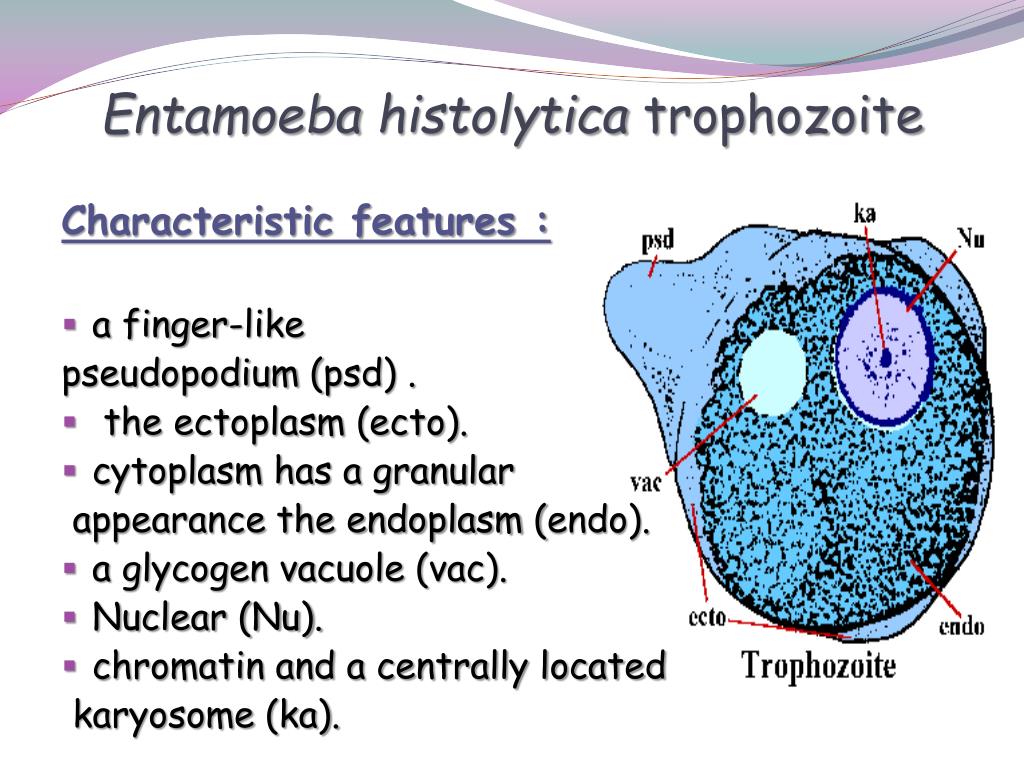
- Improved sanitation: Proper disposal of human waste and access to clean toilets.
- Safe water supply: Treatment and protection of water sources to prevent contamination.
- Personal hygiene: Regular handwashing, especially before handling food and after using the toilet.
- Food safety: Washing fruits and vegetables thoroughly, avoiding raw or undercooked foods in endemic areas.
- Education: Raising awareness about transmission routes and prevention strategies.
- Travel precautions: Taking care with food and water consumption when visiting endemic areas.
Complications and Long-term Consequences of Amebiasis
While many cases of amebiasis resolve without significant complications, severe or untreated infections can lead to serious health consequences.
What are the potential complications of untreated amebiasis?
Untreated E. histolytica infection may result in:
- Fulminant colitis: A severe form of amoebic colitis that can lead to colon perforation and peritonitis.
- Toxic megacolon: Extreme dilatation of the colon, which can be life-threatening.
- Liver abscess rupture: This can lead to peritonitis or, if the abscess ruptures into the pleural cavity, empyema.
- Brain abscess: A rare but severe complication of disseminated amebiasis.
- Chronic post-infectious irritable bowel syndrome: Some patients may develop long-term gastrointestinal symptoms after acute amebiasis.
Early diagnosis and appropriate treatment are essential to prevent these potentially life-threatening complications.

Future Directions in Amebiasis Research and Management
As E. histolytica continues to pose a significant global health challenge, ongoing research is crucial for improving our understanding of the parasite and developing more effective strategies for prevention and treatment.
What are the current areas of focus in amebiasis research?
Current research efforts are concentrating on:
- Vaccine development: Creating an effective vaccine against E. histolytica could significantly reduce disease burden in endemic areas.
- New drug targets: Identifying novel therapeutic targets to overcome potential drug resistance and improve treatment efficacy.
- Rapid diagnostic tools: Developing point-of-care tests for quick and accurate diagnosis, especially in resource-limited settings.
- Host-parasite interactions: Understanding the molecular mechanisms of pathogenesis to identify new intervention strategies.
- Epidemiological studies: Conducting large-scale studies to better understand transmission patterns and risk factors in different populations.
These research directions hold promise for improving the prevention, diagnosis, and treatment of amebiasis, ultimately reducing its global impact on human health.

Entamoeba histolytica Infection – StatPearls
Continuing Education Activity
Entamoeba histolytica is a protozoan that causes intestinal amebiasis as well as extra-intestinal manifestations. Although 90 percent of E. histolytica infections are asymptomatic, nearly 50 million people become symptomatic, with about 100,000 deaths yearly. This activity reviews the evaluation and treatment of amebiasis caused by Entamoeba histolytica and highlights the role of the interprofessional team in evaluating and treating patients with this condition.
Objectives:
Identify the etiology of Entamoeba histolytica medical conditions and emergencies.
Describe components of evaluation in the work-up for Entamoeba histolytica.
Summarize the management options available for Entamoeba histolytica.
Outline interprofessional team strategies for improving care coordination and communication to advance Entamoeba histolytica and improve outcomes.

Access free multiple choice questions on this topic.
Introduction
Entamoeba histolytica is a protozoan that causes intestinal amebiasis as well as extraintestinal manifestations. Although 90 percent of E. histolytica infections are asymptomatic, nearly 50 million people become symptomatic, with about 100,000 deaths yearly.[1] Amebic infections are more prevalent in countries with lower socioeconomic conditions.[2]
Etiology
Entamoeba histolytica is transmitted by the ingestion of amebic cysts through fecal-oral contact, usually through contaminated food or water sources.[3][4]
Epidemiology
Entamoeba histolytica continues to be an important global health issue being the third leading cause of death from parasitic infections.[5] Although 90 percent of E. histolytica infections are asymptomatic, nearly 50 million people become symptomatic, with up to 100,000 deaths yearly.[6] Those infected by Entamoeba are mostly colonized by either E. histolytica or E. dispar. E. histolytica is the pathogenic form and can cause amoebic colitis and extraintestinal amoebiasis. E. dispar is considered to be nonpathogenic and causes no signs of disease.[2]
histolytica or E. dispar. E. histolytica is the pathogenic form and can cause amoebic colitis and extraintestinal amoebiasis. E. dispar is considered to be nonpathogenic and causes no signs of disease.[2]
Infection occurs worldwide, with a higher prevalence in countries of low socioeconomic status and poor public health. Countries with a high rate of infections include India, Africa, Mexico, and Central and South America. For example, a three-year study conducted in Bangladesh showed that 2.2% of dysentery cases were caused by E. histolytica in preschool children.[7] In rural areas of Mexico, the seroprevalence of E. histolytica has been reported as high as 42%.[8] Risk factors for infection are mostly related to fecal-oral transmission and have been due to poor hand hygiene, defecation into water sources such as rivers, and being in close proximity with animals. In developed countries such as the United States, amebiasis infections are rare, accounting for at least 5 deaths per year, and are commonly seen in individuals that have had exposure to endemic areas such as immigrants or recent travelers.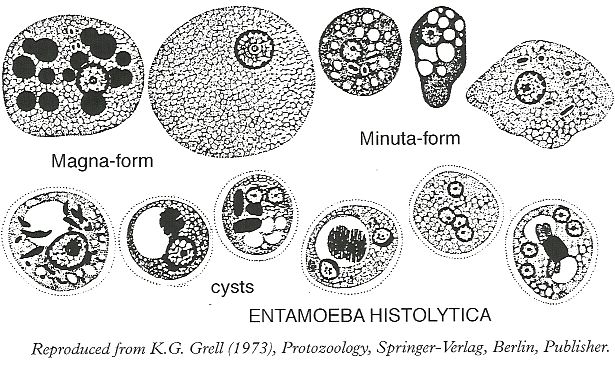 [8]
[8]
Amoebic colitis generally affects males and females of all ages equally. There are reports of increased risk of infection from gay or bisexual males due to the risk of fecal-oral contamination through oral and anal sex.[2] Factors that are associated with increased risk for complicated infection and mortality are associated with the following: pregnancy, corticosteroid treatment, malignancy, malnutrition, and alcoholism. Amoebic liver abscess infections are at least 3 times more likely to affect middle-aged men between the ages of 18 and 50.[2]
Pathophysiology
There are two forms E. histolytica can take: the cyst form, which can survive in the environment for a prolonged period, and the trophozoite stage, which is the active and invasive form. After the ingestion of the cyst form, trophozoites can be formed, which can invade and penetrate intestinal mucosa destroying epithelial cells and inflammatory cells.
The pathogenesis of infection by trophozoites is due to the adherence of colonic epithelial cells through a specific galactose-N-acetylgalactosamine lectin. [2] Through the direct adherence of trophozoites to the colonic epithelial cells, the colonic epithelial cells die off through cytolysis and apoptosis, which results in the release of interleukin-1α and precursor interleukin-1β. IL-1β activates NF-κB in distal cells to produce cytokines and other inflammatory mediators such as COX-2, interleukin-1, and interleukin-8. Amoebic cysteine proteinases can also convert precursor IL-1β to active IL-1β, which can further facilitate the process. These cytokines and inflammatory mediators subsequently attract neutrophils and macrophages. Neutrophils can be damaged by direct contact with trophozoites which can cause more damage to colonic epithelial cells resulting in the release of more mediators. Macrophages release other mediators as well, such as TNFα, which further contributes to inflammation.
[2] Through the direct adherence of trophozoites to the colonic epithelial cells, the colonic epithelial cells die off through cytolysis and apoptosis, which results in the release of interleukin-1α and precursor interleukin-1β. IL-1β activates NF-κB in distal cells to produce cytokines and other inflammatory mediators such as COX-2, interleukin-1, and interleukin-8. Amoebic cysteine proteinases can also convert precursor IL-1β to active IL-1β, which can further facilitate the process. These cytokines and inflammatory mediators subsequently attract neutrophils and macrophages. Neutrophils can be damaged by direct contact with trophozoites which can cause more damage to colonic epithelial cells resulting in the release of more mediators. Macrophages release other mediators as well, such as TNFα, which further contributes to inflammation.
The pathological range includes mucosal inflammation, thickening, ulcers, and necrosis, leading to perforation. Amoebic cysteine proteinases can also contribute to trophozoites’ ability to suppress a host’s immune response by being able to cleave and inactivate anaphylatoxins C3a, C5a, IgA, and IgG. [2] Trophozoites can reach other areas of the body, most commonly the liver, which can cause tissue necrosis and abscess formation.[7]
[2] Trophozoites can reach other areas of the body, most commonly the liver, which can cause tissue necrosis and abscess formation.[7]
History and Physical
The majority of E. histolytica infections are asymptomatic; however, up to 10% of asymptomatic individuals infected can develop the disease over time.[8] E. histolytica most commonly causes intestinal amoebiasis but can also affect the liver, respiratory tract, heart, and brain.
Gastrointestinal: Symptoms typically have a gradual onset, usually over one to three weeks. Common symptoms include diarrhea, bloody stools, weight loss, and abdominal pain.[2]
Liver: Amoebic liver abscess formation is the most common extraintestinal complication. It can be seen in months to years after an individual has had exposure to an endemic area. Symptoms include fever and right upper quadrant pain. Exam findings may include hepatomegaly with hepatic tenderness. Less than 10 percent of patients have jaundice.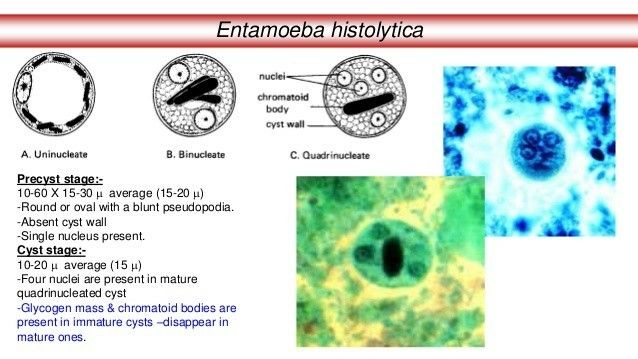 Common laboratory findings include leukocytosis without eosinophilia, elevated alkaline phosphatase, transaminitis, and elevated erythrocyte sedimentation rate.
Common laboratory findings include leukocytosis without eosinophilia, elevated alkaline phosphatase, transaminitis, and elevated erythrocyte sedimentation rate.
Respiratory tract: Pleuropulmonary involvement is a rare complication that causes atelectasis and transudative pleural effusions. In rare cases, an amoebic liver abscess can rupture into the pleural space causing empyema or hepato-bronchial fistula causing fevers, coughing, and respiratory distress.[2]
Cardiac infection: Cardiac infection is an even less common complication than pleuropulmonary disease and occurs with a liver abscess ruptures into the pericardium and presents with symptoms of pericarditis or cardiac tamponade.
Brain infection: Amoebic brain abscesses are very rare with sudden onset symptoms such as headache, vomiting, and mental status changes with rapid progression to death.[2]
Evaluation
Historically amoebic infections were diagnosed by microscopy with the identification of trophozoites; however, this method was unable to distinguish between E. histolytica and E. dispar infections. Now, there are many tools used for diagnosis with stool polymerase chain reaction (PCR) having the highest sensitivity in distinguishing E. histolytica from E. dispar. Other diagnostic modalities available include stool microscopy, stool antigen detection, serology, stool molecular studies, and colonoscopy with a histologic examination.[2]
histolytica and E. dispar infections. Now, there are many tools used for diagnosis with stool polymerase chain reaction (PCR) having the highest sensitivity in distinguishing E. histolytica from E. dispar. Other diagnostic modalities available include stool microscopy, stool antigen detection, serology, stool molecular studies, and colonoscopy with a histologic examination.[2]
Stool microscopy: This diagnostic method is advantageous, being widely available with minimal equipment needed and can be used to screen for other parasites. Disadvantages include poor sensitivity, reported at <60%, with the inability to differentiate from other Entamoeba species and relies on the experience or skills of the observer.[8][9]
Stool antigen detection: This method is simple with a quick turnaround time and has the advantage of being able to differentiate between E. histolytica and E. dispar. There are a wide number of commercially available antigen detection kits using enzyme-linked immunosorbent assay (ELISA), radioimmunoassay, or immunofluorescence that have varying sensitivities of up to 88%. [10][8][9]
[10][8][9]
Serology: Has high sensitivity and specificity with quick turnaround time but is not helpful in distinguishing between an acute or previous infection. Antibodies are not detectable in an active infection until at least a week into the infection and will remain detectable in individuals for years.
Stool molecular studies: Considered to be the gold standard with high sensitivity of 92% to 100% and specificity of 89% to 100%. Testing is becoming more widely available but is considered to be more expensive, requiring appropriate equipment and kits and requiring a skilled technician.
Colonoscopy with histologic examination: Not used for routine diagnosis but can be used to look for other causes of symptoms. Used to look for characteristic findings of amebic ulcers or erosions with the identification of trophozoites or cysts with biopsy specimens.[8]
Treatment / Management
Due to the risk of spread and the risk of developing extraintestinal manifestations, all E. histolytica infections need to be treated.
histolytica infections need to be treated.
Metronidazole is the first-line treatment for intestinal amebiasis and amebic liver abscess followed by a luminal agent. Typical dosing for metronidazole is 500 to 750 mg orally 3 times a day for 7 to 10 days in adults.[2] Metronidazole can be safely used in children at a dosing of 35 mg/kg to 50 mg/kg per day divided into three doses.[2] Luminal agents include the following: paromomycin, diiodohydroxyquin, or diloxanide furoate. Dosing for paromomycin is 25 mg/kg to 30 mg/kg per day divided into three doses for 7 days, diiodohydroxyquin is 650 mg orally for 20 days, diloxanide furoate is 500 mg orally three times a day for 10 days.[2]
Alternatives to metronidazole include tinidazole, ornidazole, and nitazoaxanide.
In patients with fulminant amoebic colitis or signs of peritonitis, broad-spectrum antibiotics should be started. Surgical intervention may be required with bowel perforation or toxic megacolon.
In uncomplicated cases of amebic liver abscess, it has been shown that there is no benefit to drainage in addition to medical therapy. [11] In situations where there is a lack of clinical response to antibiotic therapy, aspiration or catheter drainage may be necessary.[2]
[11] In situations where there is a lack of clinical response to antibiotic therapy, aspiration or catheter drainage may be necessary.[2]
Pleuropulmonary infections should be treated by aspiration of amebic pleural effusion followed by antimicrobial therapy such as metronidazole with a luminal agent.[12]
Differential Diagnosis
The differential diagnosis for E. histolytica intestinal amebiasis includes:
Bacterial pathogens: Shigella, Escherichia coli, Salmonella, Campylobacter, and Clostridioides difficile
Inflammatory bowel disease
Ischemic bowel disease
The differential diagnosis for E. histolytica extraintestinal amebiasis includes:
Pyogenic liver abscess
Echinococcal disease
Malignancy
Prognosis
Uncomplicated infections and early treatment have a mortality rate of less than 1 percent. Risk factors for complicated infections and increased mortality include the following:[13]
Fulminant amoebic colitis is associated with 40% mortality. [13] Amebic liver abscess with prompt medical treatment has been highly effective, with mortality rates between 1 and 3 percent.[2] Pleuropulmonary amebiasis is associated with mortality up to 16%, while cardiac involvement has a mortality of up to 30%.[14]
[13] Amebic liver abscess with prompt medical treatment has been highly effective, with mortality rates between 1 and 3 percent.[2] Pleuropulmonary amebiasis is associated with mortality up to 16%, while cardiac involvement has a mortality of up to 30%.[14]
Complications
Complications of E. histolytica infection can involve any of the following:[2]
Asymptomatic infection
Symptomatic noninvasive infection
Acute proctocolitis
Fulminant amoebic colitis with perforation
Toxic megacolon
Chronic non-dysenteric colitis
Extraintestinal conditions resulting from E. histolytica infection include the following:[2][15][16]
Liver abscess
Pleuropulmonary disease
Brain abscess
Peritonitis
Pericarditis
Genitourinary disease
Perianal cutaneous amebiasis
Hepatic vein thrombosis
Inferior vena cava thrombosis
Ameboma
Appendicitis
Deterrence and Patient Education
You can reduce your chances of getting bacterial and parasitic infections such as E.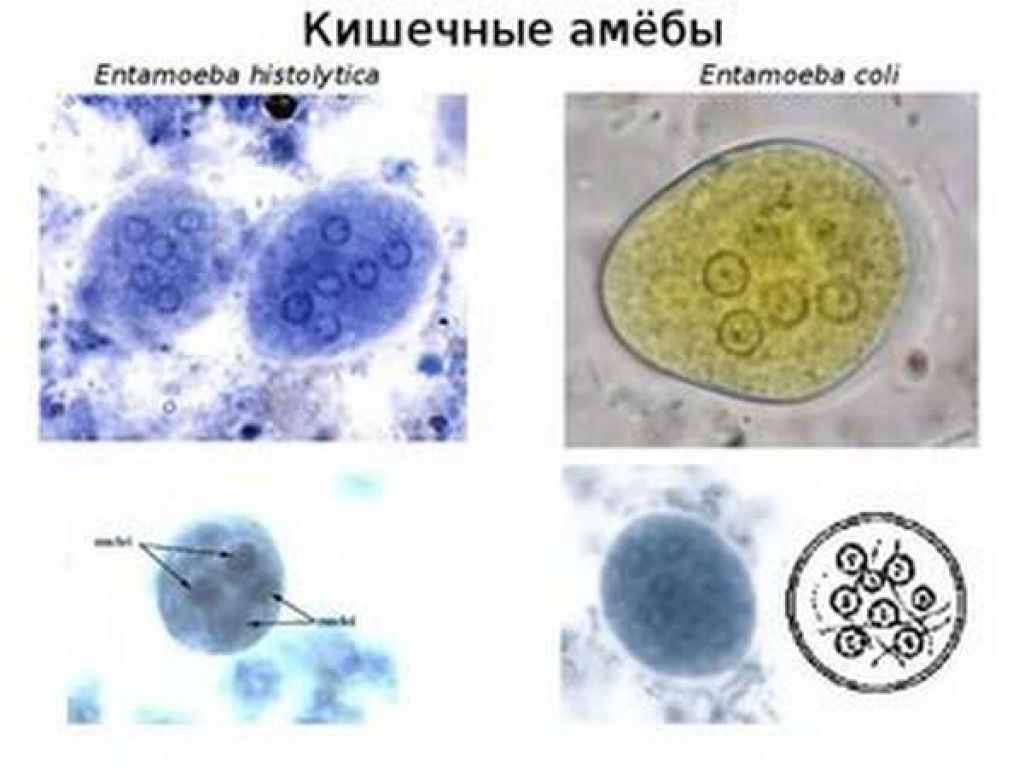 histolytica by watching what you eat and proper hand hygiene. If a person is traveling outside of the United States, they need to be sure to do the following:
histolytica by watching what you eat and proper hand hygiene. If a person is traveling outside of the United States, they need to be sure to do the following:
Avoid drinking tap water. Drink bottled beverages and brush your teeth with bottled water. Avoid ice in drinks as they are commonly made from tap water.
Avoid eating raw fruits and vegetables cleaned with tap water.
Eat well-cooked food when traveling, avoiding undercooked fish or meats.
Avoid eating street vendors in carts or stands.
Frequently wash hands after using the restroom, touching animals, before eating, or handling trash.
A patient should see a clinician if you have any of the following symptoms with any recent travel out of the country if:
They have a fever of 102 degrees F (40 degrees C) or higher.
They have severe abdominal pain.
They have bloody diarrhea.
They have been sick for longer than two weeks.

Enhancing Healthcare Team Outcomes
Amebiasis is a relatively common parasitic infection worldwide. Occurring much more commonly in endemic areas of poor socioeconomic status. An important component of prevention is patient education through interprofessional communication. Physicians, nurse practitioners, nurses, and pharmacists should educate patients if they are traveling to endemic areas in the world on common steps they can take to reduce their chance of contracting amebiasis. Specifically, they should educate patients to avoid consumption of tap water and avoid raw fruits and vegetables that have been cleaned with tap water. Patients should be encouraged to contact their healthcare provider if they have symptoms of diarrhea and blood stools after traveling to an endemic area. Open communication, especially in obtaining a good history, will be critical in early diagnosis and treatment. Following treatment, the prognosis has been proven to be favorable.[17]
Review Questions
Access free multiple choice questions on this topic.

Comment on this article.
References
- 1.
Bercu TE, Petri WA, Behm JW. Amebic colitis: new insights into pathogenesis and treatment. Curr Gastroenterol Rep. 2007 Oct;9(5):429-33. [PubMed: 17991346]
- 2.
Stanley SL. Amoebiasis. Lancet. 2003 Mar 22;361(9362):1025-34. [PubMed: 12660071]
- 3.
Salit IE, Khairnar K, Gough K, Pillai DR. A possible cluster of sexually transmitted Entamoeba histolytica: genetic analysis of a highly virulent strain. Clin Infect Dis. 2009 Aug 01;49(3):346-53. [PubMed: 19580413]
- 4.
Billet AC, Salmon Rousseau A, Piroth L, Martins C. An underestimated sexually transmitted infection: amoebiasis. BMJ Case Rep. 2019 May 10;12(5) [PMC free article: PMC6536245] [PubMed: 31079045]
- 5.
Ghosh S, Padalia J, Moonah S. Tissue Destruction Caused by Entamoeba histolytica Parasite: Cell Death, Inflammation, Invasion, and the Gut Microbiome.
 Curr Clin Microbiol Rep. 2019;6(1):51-57. [PMC free article: PMC6449278] [PubMed: 31008019]
Curr Clin Microbiol Rep. 2019;6(1):51-57. [PMC free article: PMC6449278] [PubMed: 31008019]- 6.
Stauffer W, Ravdin JI. Entamoeba histolytica: an update. Curr Opin Infect Dis. 2003 Oct;16(5):479-85. [PubMed: 14502002]
- 7.
Haque R, Huston CD, Hughes M, Houpt E, Petri WA. Amebiasis. N Engl J Med. 2003 Apr 17;348(16):1565-73. [PubMed: 12700377]
- 8.
Shirley DT, Farr L, Watanabe K, Moonah S. A Review of the Global Burden, New Diagnostics, and Current Therapeutics for Amebiasis. Open Forum Infect Dis. 2018 Jul;5(7):ofy161. [PMC free article: PMC6055529] [PubMed: 30046644]
- 9.
Saidin S, Othman N, Noordin R. Update on laboratory diagnosis of amoebiasis. Eur J Clin Microbiol Infect Dis. 2019 Jan;38(1):15-38. [PubMed: 30255429]
- 10.
Spadafora LJ, Kearney MR, Siddique A, Ali IK, Gilchrist CA, Arju T, Hoffstrom B, Nguyen FK, Petri WA, Haque R, Cangelosi GA. Species-Specific Immunodetection of an Entamoeba histolytica Cyst Wall Protein.
 PLoS Negl Trop Dis. 2016 May;10(5):e0004697. [PMC free article: PMC4859568] [PubMed: 27152855]
PLoS Negl Trop Dis. 2016 May;10(5):e0004697. [PMC free article: PMC4859568] [PubMed: 27152855]- 11.
Chavez-Tapia NC, Hernandez-Calleros J, Tellez-Avila FI, Torre A, Uribe M. Image-guided percutaneous procedure plus metronidazole versus metronidazole alone for uncomplicated amoebic liver abscess. Cochrane Database Syst Rev. 2009 Jan 21;(1):CD004886. [PubMed: 19160244]
- 12.
Fung HB, Doan TL. Tinidazole: a nitroimidazole antiprotozoal agent. Clin Ther. 2005 Dec;27(12):1859-84. [PubMed: 16507373]
- 13.
Kantor M, Abrantes A, Estevez A, Schiller A, Torrent J, Gascon J, Hernandez R, Ochner C. Entamoeba Histolytica: Updates in Clinical Manifestation, Pathogenesis, and Vaccine Development. Can J Gastroenterol Hepatol. 2018;2018:4601420. [PMC free article: PMC6304615] [PubMed: 30631758]
- 14.
Zakaria A, Al-Share B, Al Asad K. Primary Pulmonary Amebiasis Complicated with Multicystic Empyema. Case Rep Pulmonol. 2016;2016:8709347.
 [PMC free article: PMC4958447] [PubMed: 27478673]
[PMC free article: PMC4958447] [PubMed: 27478673]- 15.
Martin L, Burute N, Haider E, Serrano PE, O’Shea T, Siegal D. Occult Amebic Liver Abscess as Cause of Extensive Inferior Vena Cava and Hepatic Vein Thrombosis. Am J Trop Med Hyg. 2017 Oct;97(4):1214-1217. [PMC free article: PMC5637618] [PubMed: 28722597]
- 16.
Ito D, Hata S, Seiichiro S, Kobayashi K, Teruya M, Kaminishi M. Amebiasis presenting as acute appendicitis: Report of a case and review of Japanese literature. Int J Surg Case Rep. 2014;5(12):1054-7. [PMC free article: PMC4275826] [PubMed: 25460473]
- 17.
Zulfiqar H, Mathew G, Horrall S. StatPearls [Internet]. StatPearls Publishing; Treasure Island (FL): Jan 31, 2023. Amebiasis. [PubMed: 30137820]
Disclosure: Arthur Chou declares no relevant financial relationships with ineligible companies.
Disclosure: Richard Austin declares no relevant financial relationships with ineligible companies.

Entamoeba histolytica Infection – StatPearls
Continuing Education Activity
Entamoeba histolytica is a protozoan that causes intestinal amebiasis as well as extra-intestinal manifestations. Although 90 percent of E. histolytica infections are asymptomatic, nearly 50 million people become symptomatic, with about 100,000 deaths yearly. This activity reviews the evaluation and treatment of amebiasis caused by Entamoeba histolytica and highlights the role of the interprofessional team in evaluating and treating patients with this condition.
Objectives:
Identify the etiology of Entamoeba histolytica medical conditions and emergencies.
Describe components of evaluation in the work-up for Entamoeba histolytica.
Summarize the management options available for Entamoeba histolytica.
Outline interprofessional team strategies for improving care coordination and communication to advance Entamoeba histolytica and improve outcomes.

Access free multiple choice questions on this topic.
Introduction
Entamoeba histolytica is a protozoan that causes intestinal amebiasis as well as extraintestinal manifestations. Although 90 percent of E. histolytica infections are asymptomatic, nearly 50 million people become symptomatic, with about 100,000 deaths yearly.[1] Amebic infections are more prevalent in countries with lower socioeconomic conditions.[2]
Etiology
Entamoeba histolytica is transmitted by the ingestion of amebic cysts through fecal-oral contact, usually through contaminated food or water sources.[3][4]
Epidemiology
Entamoeba histolytica continues to be an important global health issue being the third leading cause of death from parasitic infections.[5] Although 90 percent of E. histolytica infections are asymptomatic, nearly 50 million people become symptomatic, with up to 100,000 deaths yearly.[6] Those infected by Entamoeba are mostly colonized by either E. histolytica or E. dispar. E. histolytica is the pathogenic form and can cause amoebic colitis and extraintestinal amoebiasis. E. dispar is considered to be nonpathogenic and causes no signs of disease.[2]
histolytica or E. dispar. E. histolytica is the pathogenic form and can cause amoebic colitis and extraintestinal amoebiasis. E. dispar is considered to be nonpathogenic and causes no signs of disease.[2]
Infection occurs worldwide, with a higher prevalence in countries of low socioeconomic status and poor public health. Countries with a high rate of infections include India, Africa, Mexico, and Central and South America. For example, a three-year study conducted in Bangladesh showed that 2.2% of dysentery cases were caused by E. histolytica in preschool children.[7] In rural areas of Mexico, the seroprevalence of E. histolytica has been reported as high as 42%.[8] Risk factors for infection are mostly related to fecal-oral transmission and have been due to poor hand hygiene, defecation into water sources such as rivers, and being in close proximity with animals. In developed countries such as the United States, amebiasis infections are rare, accounting for at least 5 deaths per year, and are commonly seen in individuals that have had exposure to endemic areas such as immigrants or recent travelers.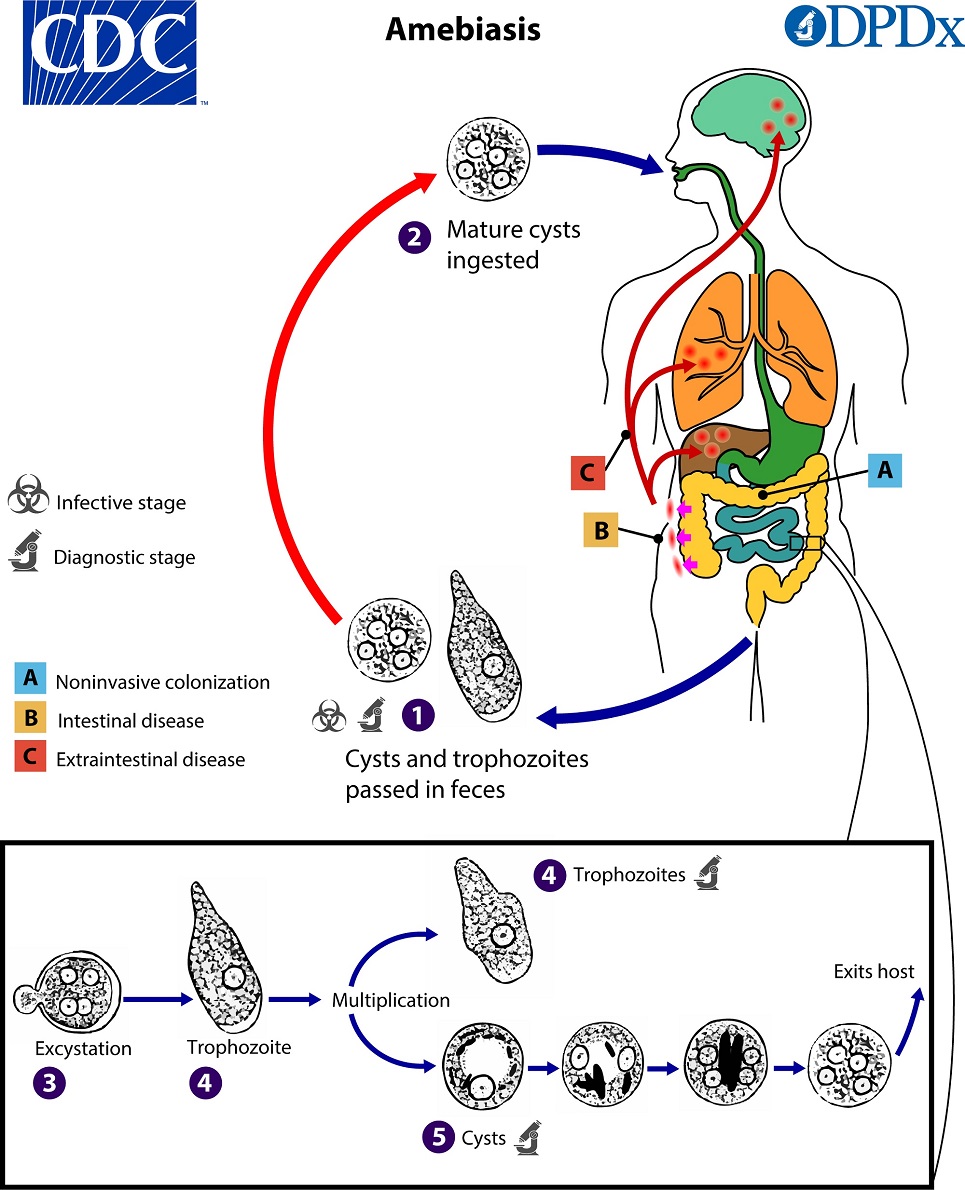 [8]
[8]
Amoebic colitis generally affects males and females of all ages equally. There are reports of increased risk of infection from gay or bisexual males due to the risk of fecal-oral contamination through oral and anal sex.[2] Factors that are associated with increased risk for complicated infection and mortality are associated with the following: pregnancy, corticosteroid treatment, malignancy, malnutrition, and alcoholism. Amoebic liver abscess infections are at least 3 times more likely to affect middle-aged men between the ages of 18 and 50.[2]
Pathophysiology
There are two forms E. histolytica can take: the cyst form, which can survive in the environment for a prolonged period, and the trophozoite stage, which is the active and invasive form. After the ingestion of the cyst form, trophozoites can be formed, which can invade and penetrate intestinal mucosa destroying epithelial cells and inflammatory cells.
The pathogenesis of infection by trophozoites is due to the adherence of colonic epithelial cells through a specific galactose-N-acetylgalactosamine lectin. [2] Through the direct adherence of trophozoites to the colonic epithelial cells, the colonic epithelial cells die off through cytolysis and apoptosis, which results in the release of interleukin-1α and precursor interleukin-1β. IL-1β activates NF-κB in distal cells to produce cytokines and other inflammatory mediators such as COX-2, interleukin-1, and interleukin-8. Amoebic cysteine proteinases can also convert precursor IL-1β to active IL-1β, which can further facilitate the process. These cytokines and inflammatory mediators subsequently attract neutrophils and macrophages. Neutrophils can be damaged by direct contact with trophozoites which can cause more damage to colonic epithelial cells resulting in the release of more mediators. Macrophages release other mediators as well, such as TNFα, which further contributes to inflammation.
[2] Through the direct adherence of trophozoites to the colonic epithelial cells, the colonic epithelial cells die off through cytolysis and apoptosis, which results in the release of interleukin-1α and precursor interleukin-1β. IL-1β activates NF-κB in distal cells to produce cytokines and other inflammatory mediators such as COX-2, interleukin-1, and interleukin-8. Amoebic cysteine proteinases can also convert precursor IL-1β to active IL-1β, which can further facilitate the process. These cytokines and inflammatory mediators subsequently attract neutrophils and macrophages. Neutrophils can be damaged by direct contact with trophozoites which can cause more damage to colonic epithelial cells resulting in the release of more mediators. Macrophages release other mediators as well, such as TNFα, which further contributes to inflammation.
The pathological range includes mucosal inflammation, thickening, ulcers, and necrosis, leading to perforation. Amoebic cysteine proteinases can also contribute to trophozoites’ ability to suppress a host’s immune response by being able to cleave and inactivate anaphylatoxins C3a, C5a, IgA, and IgG.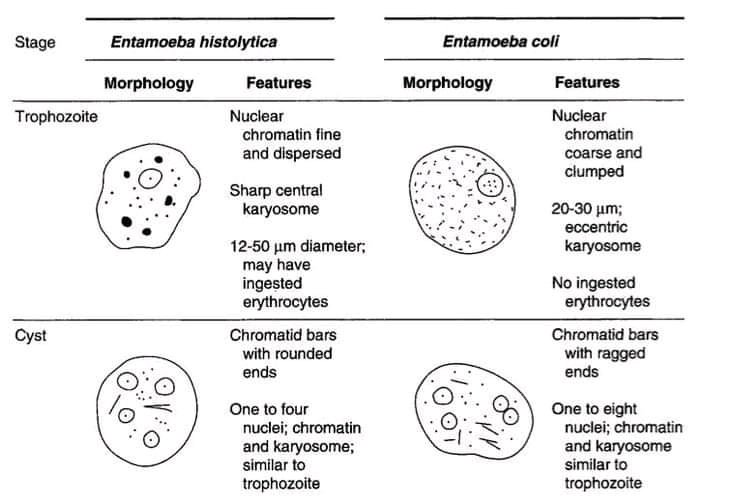 [2] Trophozoites can reach other areas of the body, most commonly the liver, which can cause tissue necrosis and abscess formation.[7]
[2] Trophozoites can reach other areas of the body, most commonly the liver, which can cause tissue necrosis and abscess formation.[7]
History and Physical
The majority of E. histolytica infections are asymptomatic; however, up to 10% of asymptomatic individuals infected can develop the disease over time.[8] E. histolytica most commonly causes intestinal amoebiasis but can also affect the liver, respiratory tract, heart, and brain.
Gastrointestinal: Symptoms typically have a gradual onset, usually over one to three weeks. Common symptoms include diarrhea, bloody stools, weight loss, and abdominal pain.[2]
Liver: Amoebic liver abscess formation is the most common extraintestinal complication. It can be seen in months to years after an individual has had exposure to an endemic area. Symptoms include fever and right upper quadrant pain. Exam findings may include hepatomegaly with hepatic tenderness. Less than 10 percent of patients have jaundice.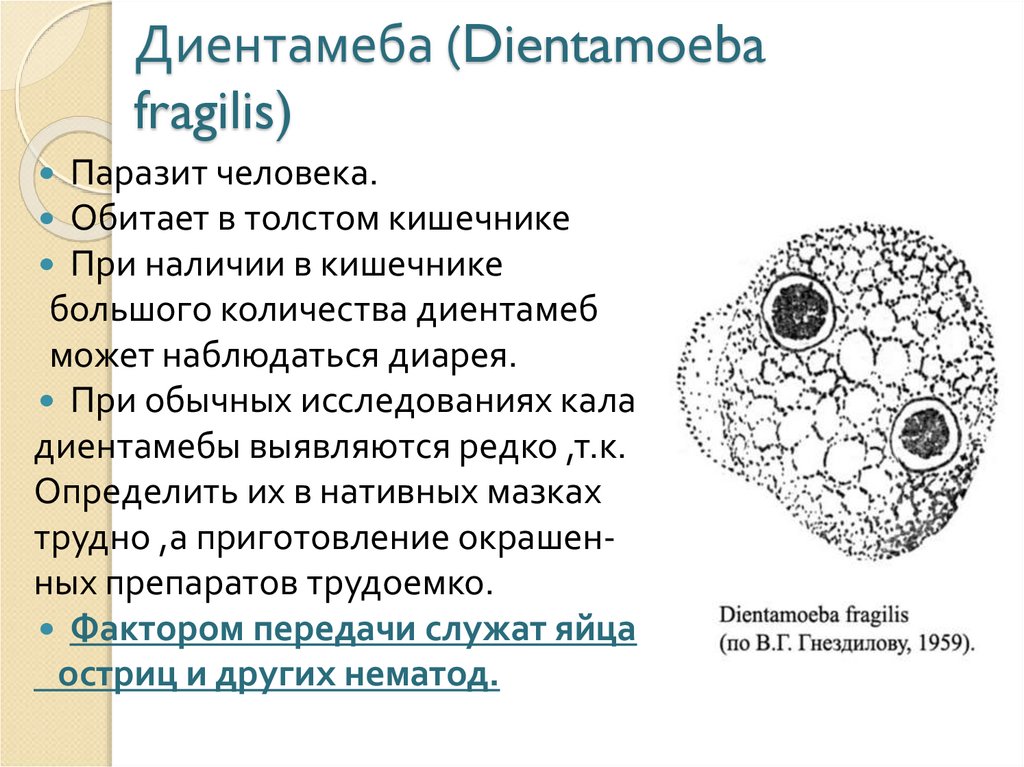 Common laboratory findings include leukocytosis without eosinophilia, elevated alkaline phosphatase, transaminitis, and elevated erythrocyte sedimentation rate.
Common laboratory findings include leukocytosis without eosinophilia, elevated alkaline phosphatase, transaminitis, and elevated erythrocyte sedimentation rate.
Respiratory tract: Pleuropulmonary involvement is a rare complication that causes atelectasis and transudative pleural effusions. In rare cases, an amoebic liver abscess can rupture into the pleural space causing empyema or hepato-bronchial fistula causing fevers, coughing, and respiratory distress.[2]
Cardiac infection: Cardiac infection is an even less common complication than pleuropulmonary disease and occurs with a liver abscess ruptures into the pericardium and presents with symptoms of pericarditis or cardiac tamponade.
Brain infection: Amoebic brain abscesses are very rare with sudden onset symptoms such as headache, vomiting, and mental status changes with rapid progression to death.[2]
Evaluation
Historically amoebic infections were diagnosed by microscopy with the identification of trophozoites; however, this method was unable to distinguish between E. histolytica and E. dispar infections. Now, there are many tools used for diagnosis with stool polymerase chain reaction (PCR) having the highest sensitivity in distinguishing E. histolytica from E. dispar. Other diagnostic modalities available include stool microscopy, stool antigen detection, serology, stool molecular studies, and colonoscopy with a histologic examination.[2]
histolytica and E. dispar infections. Now, there are many tools used for diagnosis with stool polymerase chain reaction (PCR) having the highest sensitivity in distinguishing E. histolytica from E. dispar. Other diagnostic modalities available include stool microscopy, stool antigen detection, serology, stool molecular studies, and colonoscopy with a histologic examination.[2]
Stool microscopy: This diagnostic method is advantageous, being widely available with minimal equipment needed and can be used to screen for other parasites. Disadvantages include poor sensitivity, reported at <60%, with the inability to differentiate from other Entamoeba species and relies on the experience or skills of the observer.[8][9]
Stool antigen detection: This method is simple with a quick turnaround time and has the advantage of being able to differentiate between E. histolytica and E. dispar. There are a wide number of commercially available antigen detection kits using enzyme-linked immunosorbent assay (ELISA), radioimmunoassay, or immunofluorescence that have varying sensitivities of up to 88%. [10][8][9]
[10][8][9]
Serology: Has high sensitivity and specificity with quick turnaround time but is not helpful in distinguishing between an acute or previous infection. Antibodies are not detectable in an active infection until at least a week into the infection and will remain detectable in individuals for years.
Stool molecular studies: Considered to be the gold standard with high sensitivity of 92% to 100% and specificity of 89% to 100%. Testing is becoming more widely available but is considered to be more expensive, requiring appropriate equipment and kits and requiring a skilled technician.
Colonoscopy with histologic examination: Not used for routine diagnosis but can be used to look for other causes of symptoms. Used to look for characteristic findings of amebic ulcers or erosions with the identification of trophozoites or cysts with biopsy specimens.[8]
Treatment / Management
Due to the risk of spread and the risk of developing extraintestinal manifestations, all E. histolytica infections need to be treated.
histolytica infections need to be treated.
Metronidazole is the first-line treatment for intestinal amebiasis and amebic liver abscess followed by a luminal agent. Typical dosing for metronidazole is 500 to 750 mg orally 3 times a day for 7 to 10 days in adults.[2] Metronidazole can be safely used in children at a dosing of 35 mg/kg to 50 mg/kg per day divided into three doses.[2] Luminal agents include the following: paromomycin, diiodohydroxyquin, or diloxanide furoate. Dosing for paromomycin is 25 mg/kg to 30 mg/kg per day divided into three doses for 7 days, diiodohydroxyquin is 650 mg orally for 20 days, diloxanide furoate is 500 mg orally three times a day for 10 days.[2]
Alternatives to metronidazole include tinidazole, ornidazole, and nitazoaxanide.
In patients with fulminant amoebic colitis or signs of peritonitis, broad-spectrum antibiotics should be started. Surgical intervention may be required with bowel perforation or toxic megacolon.
In uncomplicated cases of amebic liver abscess, it has been shown that there is no benefit to drainage in addition to medical therapy.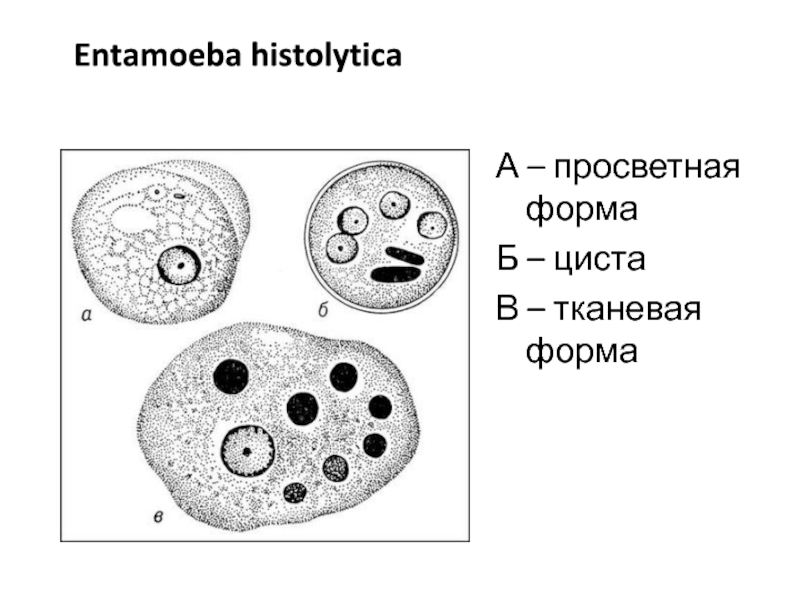 [11] In situations where there is a lack of clinical response to antibiotic therapy, aspiration or catheter drainage may be necessary.[2]
[11] In situations where there is a lack of clinical response to antibiotic therapy, aspiration or catheter drainage may be necessary.[2]
Pleuropulmonary infections should be treated by aspiration of amebic pleural effusion followed by antimicrobial therapy such as metronidazole with a luminal agent.[12]
Differential Diagnosis
The differential diagnosis for E. histolytica intestinal amebiasis includes:
Bacterial pathogens: Shigella, Escherichia coli, Salmonella, Campylobacter, and Clostridioides difficile
Inflammatory bowel disease
Ischemic bowel disease
The differential diagnosis for E. histolytica extraintestinal amebiasis includes:
Pyogenic liver abscess
Echinococcal disease
Malignancy
Prognosis
Uncomplicated infections and early treatment have a mortality rate of less than 1 percent. Risk factors for complicated infections and increased mortality include the following:[13]
Fulminant amoebic colitis is associated with 40% mortality. [13] Amebic liver abscess with prompt medical treatment has been highly effective, with mortality rates between 1 and 3 percent.[2] Pleuropulmonary amebiasis is associated with mortality up to 16%, while cardiac involvement has a mortality of up to 30%.[14]
[13] Amebic liver abscess with prompt medical treatment has been highly effective, with mortality rates between 1 and 3 percent.[2] Pleuropulmonary amebiasis is associated with mortality up to 16%, while cardiac involvement has a mortality of up to 30%.[14]
Complications
Complications of E. histolytica infection can involve any of the following:[2]
Asymptomatic infection
Symptomatic noninvasive infection
Acute proctocolitis
Fulminant amoebic colitis with perforation
Toxic megacolon
Chronic non-dysenteric colitis
Extraintestinal conditions resulting from E. histolytica infection include the following:[2][15][16]
Liver abscess
Pleuropulmonary disease
Brain abscess
Peritonitis
Pericarditis
Genitourinary disease
Perianal cutaneous amebiasis
Hepatic vein thrombosis
Inferior vena cava thrombosis
Ameboma
Appendicitis
Deterrence and Patient Education
You can reduce your chances of getting bacterial and parasitic infections such as E.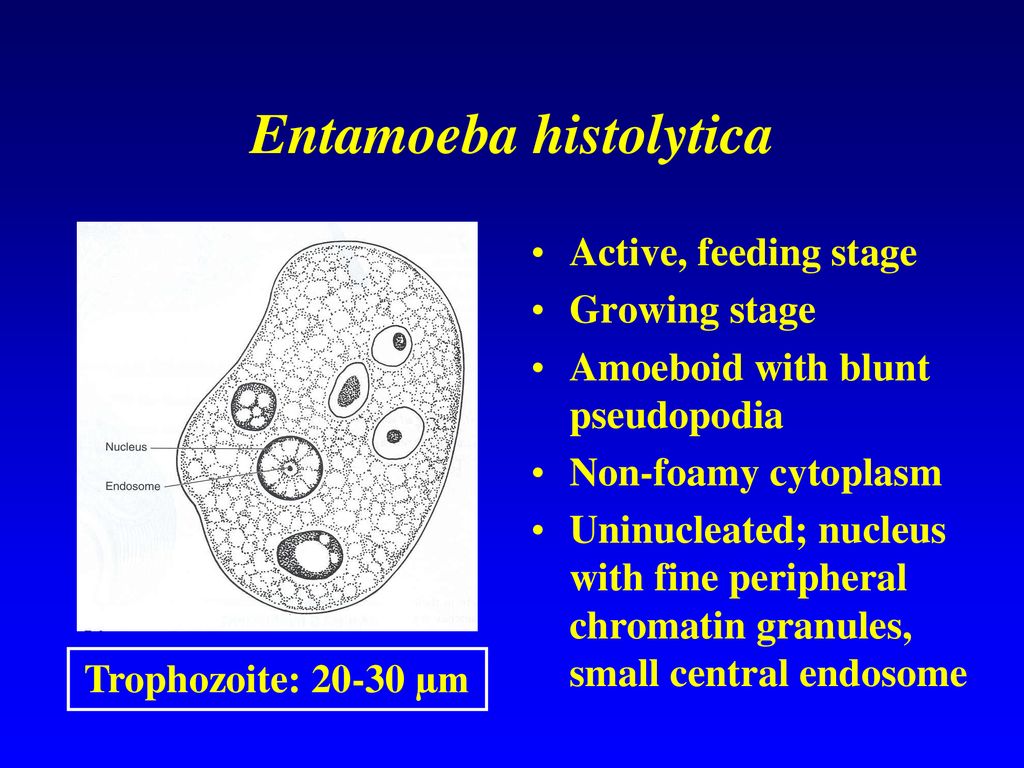 histolytica by watching what you eat and proper hand hygiene. If a person is traveling outside of the United States, they need to be sure to do the following:
histolytica by watching what you eat and proper hand hygiene. If a person is traveling outside of the United States, they need to be sure to do the following:
Avoid drinking tap water. Drink bottled beverages and brush your teeth with bottled water. Avoid ice in drinks as they are commonly made from tap water.
Avoid eating raw fruits and vegetables cleaned with tap water.
Eat well-cooked food when traveling, avoiding undercooked fish or meats.
Avoid eating street vendors in carts or stands.
Frequently wash hands after using the restroom, touching animals, before eating, or handling trash.
A patient should see a clinician if you have any of the following symptoms with any recent travel out of the country if:
They have a fever of 102 degrees F (40 degrees C) or higher.
They have severe abdominal pain.
They have bloody diarrhea.
They have been sick for longer than two weeks.

Enhancing Healthcare Team Outcomes
Amebiasis is a relatively common parasitic infection worldwide. Occurring much more commonly in endemic areas of poor socioeconomic status. An important component of prevention is patient education through interprofessional communication. Physicians, nurse practitioners, nurses, and pharmacists should educate patients if they are traveling to endemic areas in the world on common steps they can take to reduce their chance of contracting amebiasis. Specifically, they should educate patients to avoid consumption of tap water and avoid raw fruits and vegetables that have been cleaned with tap water. Patients should be encouraged to contact their healthcare provider if they have symptoms of diarrhea and blood stools after traveling to an endemic area. Open communication, especially in obtaining a good history, will be critical in early diagnosis and treatment. Following treatment, the prognosis has been proven to be favorable.[17]
Review Questions
Access free multiple choice questions on this topic.

Comment on this article.
References
- 1.
Bercu TE, Petri WA, Behm JW. Amebic colitis: new insights into pathogenesis and treatment. Curr Gastroenterol Rep. 2007 Oct;9(5):429-33. [PubMed: 17991346]
- 2.
Stanley SL. Amoebiasis. Lancet. 2003 Mar 22;361(9362):1025-34. [PubMed: 12660071]
- 3.
Salit IE, Khairnar K, Gough K, Pillai DR. A possible cluster of sexually transmitted Entamoeba histolytica: genetic analysis of a highly virulent strain. Clin Infect Dis. 2009 Aug 01;49(3):346-53. [PubMed: 19580413]
- 4.
Billet AC, Salmon Rousseau A, Piroth L, Martins C. An underestimated sexually transmitted infection: amoebiasis. BMJ Case Rep. 2019 May 10;12(5) [PMC free article: PMC6536245] [PubMed: 31079045]
- 5.
Ghosh S, Padalia J, Moonah S. Tissue Destruction Caused by Entamoeba histolytica Parasite: Cell Death, Inflammation, Invasion, and the Gut Microbiome.
 Curr Clin Microbiol Rep. 2019;6(1):51-57. [PMC free article: PMC6449278] [PubMed: 31008019]
Curr Clin Microbiol Rep. 2019;6(1):51-57. [PMC free article: PMC6449278] [PubMed: 31008019]- 6.
Stauffer W, Ravdin JI. Entamoeba histolytica: an update. Curr Opin Infect Dis. 2003 Oct;16(5):479-85. [PubMed: 14502002]
- 7.
Haque R, Huston CD, Hughes M, Houpt E, Petri WA. Amebiasis. N Engl J Med. 2003 Apr 17;348(16):1565-73. [PubMed: 12700377]
- 8.
Shirley DT, Farr L, Watanabe K, Moonah S. A Review of the Global Burden, New Diagnostics, and Current Therapeutics for Amebiasis. Open Forum Infect Dis. 2018 Jul;5(7):ofy161. [PMC free article: PMC6055529] [PubMed: 30046644]
- 9.
Saidin S, Othman N, Noordin R. Update on laboratory diagnosis of amoebiasis. Eur J Clin Microbiol Infect Dis. 2019 Jan;38(1):15-38. [PubMed: 30255429]
- 10.
Spadafora LJ, Kearney MR, Siddique A, Ali IK, Gilchrist CA, Arju T, Hoffstrom B, Nguyen FK, Petri WA, Haque R, Cangelosi GA. Species-Specific Immunodetection of an Entamoeba histolytica Cyst Wall Protein.
 PLoS Negl Trop Dis. 2016 May;10(5):e0004697. [PMC free article: PMC4859568] [PubMed: 27152855]
PLoS Negl Trop Dis. 2016 May;10(5):e0004697. [PMC free article: PMC4859568] [PubMed: 27152855]- 11.
Chavez-Tapia NC, Hernandez-Calleros J, Tellez-Avila FI, Torre A, Uribe M. Image-guided percutaneous procedure plus metronidazole versus metronidazole alone for uncomplicated amoebic liver abscess. Cochrane Database Syst Rev. 2009 Jan 21;(1):CD004886. [PubMed: 19160244]
- 12.
Fung HB, Doan TL. Tinidazole: a nitroimidazole antiprotozoal agent. Clin Ther. 2005 Dec;27(12):1859-84. [PubMed: 16507373]
- 13.
Kantor M, Abrantes A, Estevez A, Schiller A, Torrent J, Gascon J, Hernandez R, Ochner C. Entamoeba Histolytica: Updates in Clinical Manifestation, Pathogenesis, and Vaccine Development. Can J Gastroenterol Hepatol. 2018;2018:4601420. [PMC free article: PMC6304615] [PubMed: 30631758]
- 14.
Zakaria A, Al-Share B, Al Asad K. Primary Pulmonary Amebiasis Complicated with Multicystic Empyema. Case Rep Pulmonol. 2016;2016:8709347.
 [PMC free article: PMC4958447] [PubMed: 27478673]
[PMC free article: PMC4958447] [PubMed: 27478673]- 15.
Martin L, Burute N, Haider E, Serrano PE, O’Shea T, Siegal D. Occult Amebic Liver Abscess as Cause of Extensive Inferior Vena Cava and Hepatic Vein Thrombosis. Am J Trop Med Hyg. 2017 Oct;97(4):1214-1217. [PMC free article: PMC5637618] [PubMed: 28722597]
- 16.
Ito D, Hata S, Seiichiro S, Kobayashi K, Teruya M, Kaminishi M. Amebiasis presenting as acute appendicitis: Report of a case and review of Japanese literature. Int J Surg Case Rep. 2014;5(12):1054-7. [PMC free article: PMC4275826] [PubMed: 25460473]
- 17.
Zulfiqar H, Mathew G, Horrall S. StatPearls [Internet]. StatPearls Publishing; Treasure Island (FL): Jan 31, 2023. Amebiasis. [PubMed: 30137820]
Disclosure: Arthur Chou declares no relevant financial relationships with ineligible companies.
Disclosure: Richard Austin declares no relevant financial relationships with ineligible companies.

Entamoeba histolytica, IgG
Assay of IgG antibodies to dysenteric amoeba that causes amoebiasis.
Synonyms Russian
Dysentery amoeba, amoebic colitis, amoebic dysentery, amoebiasis, IgG class antibodies to dysentery amoeba.
Synonyms English
Test method
Immunoassay.
What biomaterial can be used for research?
Venous blood.
How to properly prepare for an examination?
- Do not smoke for 30 minutes before the test.
General information about the study
Entamoeba histolytica is one of many species of amoeba, the dysentery amoeba, which is the causative agent of the disease amoebiasis (amebic dysentery, or amoebic colitis). Most of the strains of this type of amoeba are not dangerous to humans and do not cause disturbances in the body.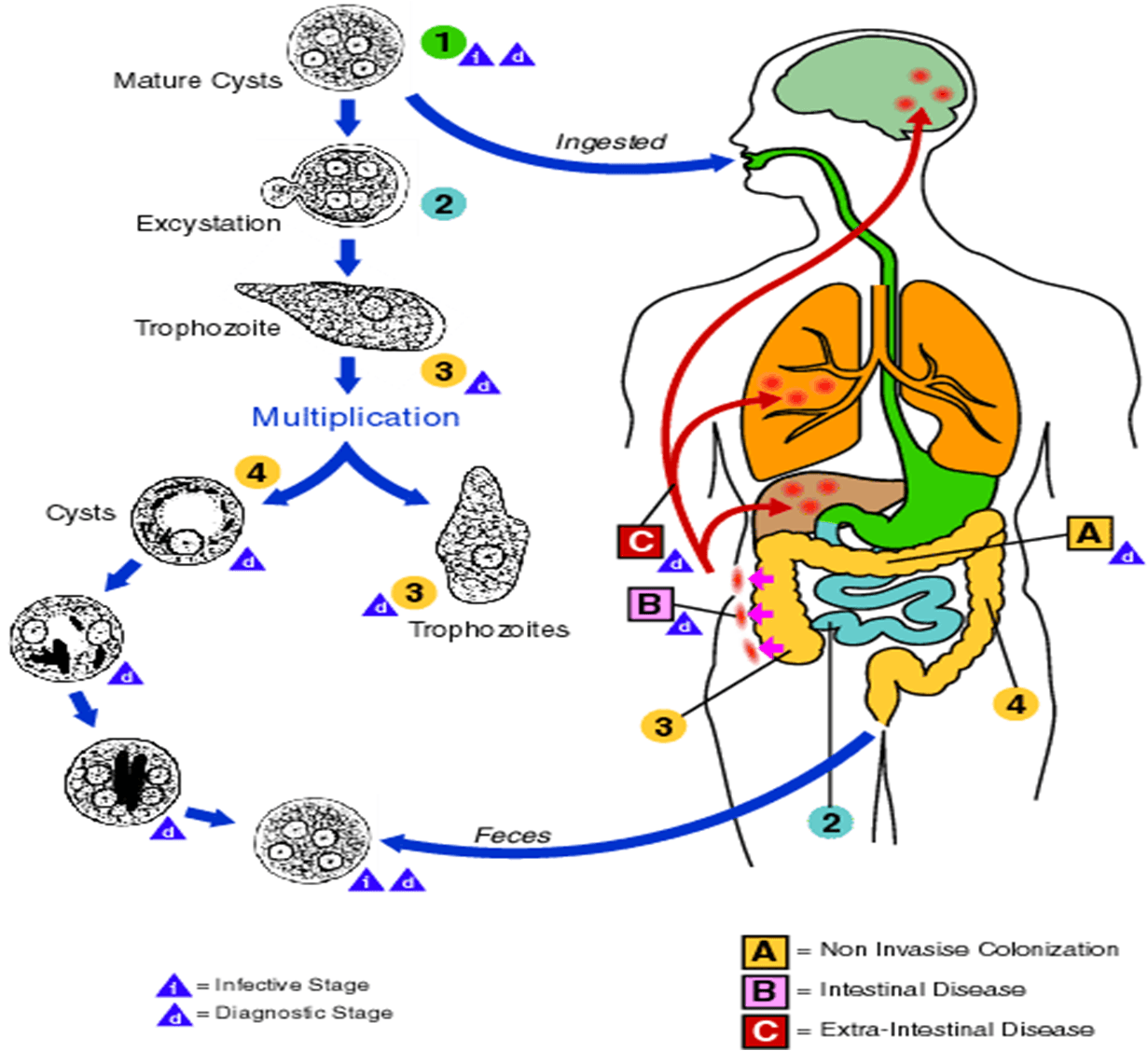 AT 9In 0% of cases of infection with a dysenteric amoeba, it immediately begins to multiply after entering the colon, but its spread does not affect the intestinal tissue, so a person does not feel any symptoms and is considered healthy, but is a carrier of a dysenteric amoeba. The fact that there are a large number of asymptomatic carriers greatly complicates the situation and puts the person at great risk of infection. As you know, representatives of all age groups of any gender can be infected.
AT 9In 0% of cases of infection with a dysenteric amoeba, it immediately begins to multiply after entering the colon, but its spread does not affect the intestinal tissue, so a person does not feel any symptoms and is considered healthy, but is a carrier of a dysenteric amoeba. The fact that there are a large number of asymptomatic carriers greatly complicates the situation and puts the person at great risk of infection. As you know, representatives of all age groups of any gender can be infected.
However, not in all cases, infection with amoebiasis occurs without a trace and unnoticed by the patient. If, in the process of its reproduction, the dysenteric amoeba can penetrate the mucous membrane of the colon, for the patient this situation threatens with inflammatory diarrhea. This is due to the fact that the mucous membrane of the colon produces specific neurohumoral substances, which, if the intestinal lining is disturbed, provoke an increased level of secretion in the intestine and damage it.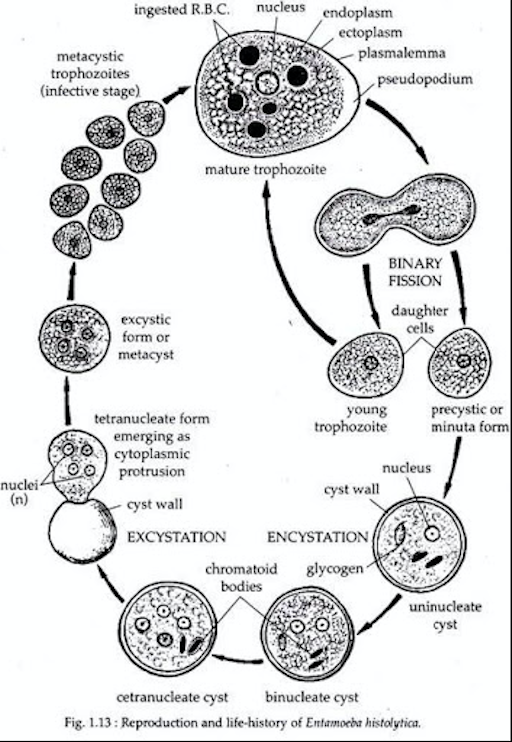 The consequences of intestinal disorders due to amoebiasis can be refractory diarrhea, fulminant dysentery and liver abscess.
The consequences of intestinal disorders due to amoebiasis can be refractory diarrhea, fulminant dysentery and liver abscess.
Amoebiasis is distributed throughout the world, but most of the infections occur in developing countries. High-risk groups include agricultural workers, children, travelers to high-risk countries, migrants, and closed communities. The main catalyst for infection is the low level of sanitary living conditions. A person becomes infected through the ingestion of contaminated food and water, as well as through the fecal-oral route. Under the contamination of food and water, it is assumed that they contain cysts – special formations formed by amoebas, which are extremely resistant to any environmental conditions due to the structure of the shell. From the cysts, in turn, trophozoites are formed – they leave the cysts already in the small intestine, then, due to their mobility, migrate to the large intestine, where they begin the process of reproduction. In the case of an invasive form of the disease, trophozoites attack the intestinal mucosa. Those trophozoites that penetrate the tissues of the colon are able to destroy them and reach the bloodstream, as a result of which the amoeba is able to spread throughout the body. Through the circulatory system, they can reach the brain, liver, lungs, causing new, already extraintestinal pathologies: liver abscess, brain abscess, peritonitis, pleuropulmonary abscess, damage to the skin and genitals.
Those trophozoites that penetrate the tissues of the colon are able to destroy them and reach the bloodstream, as a result of which the amoeba is able to spread throughout the body. Through the circulatory system, they can reach the brain, liver, lungs, causing new, already extraintestinal pathologies: liver abscess, brain abscess, peritonitis, pleuropulmonary abscess, damage to the skin and genitals.
Analysis of blood serum for the content of IgG antibodies to Entamoeba histolytica allows not only to diagnose the presence of invasive amoebiasis in a patient, but also to identify the fact of asymptomatic carriage, as well as to determine previous cases of non-invasive amoebiasis.
What is research used for?
- For the diagnosis of amoebiasis;
- for the purpose of differential diagnosis of chronic liver diseases, ulcerative colitis, etc.
What do the results mean?
Reference values: negative.
Who orders the examination?
Gastroenterologist, pediatrician, therapist.
Literature
- Bogomolov B.P. Infectious diseases: Textbook M.: Publishing House of Moscow State University, 2009.
- A. P. Kazantsev, V. S. Matkovsky. Handbook of infectious diseases. – M.: Medicine. – 1979.
- A. R. Reizis. Hospital infections in modern medicine. – St. Petersburg: Rudi-Bars. – 1993.
- Heiman F.L. Wertheim, Peter Horby and John P. Woodall – Atlas of Human Infectious Diseases, First Edition, 2012, Blackwell Publishing Ltd.
- Samuel L Stanley. Amoebiasis. The Lancet – 22 March 2003 (Vol. 361, Issue 9362, Pages 1025 – 1034).
causes of the disease and treatment, symptoms of amebiasis and diagnosis
Amoebiasis
Table of contents
- Amoebiasis – what is it?
- Causes of amoebiasis
- Symptoms and diagnosis of amoebiasis
- Treatment of amoebiasis
- Prevention
- Treatment of amoebiasis at Mama Papa Ya clinic
Amoebiasis is an intestinal disease caused by protozoan organisms and is observed only in humans. Pathology often takes a chronic course, accompanied by the formation of ulcers on the walls of the colon and the formation of abscesses in the internal organs.
Pathology often takes a chronic course, accompanied by the formation of ulcers on the walls of the colon and the formation of abscesses in the internal organs.
Amoebiasis – what is it?
Amoebiasis is common in tropical countries with poor sanitation, India, parts of Central and South America and Africa. Rarely seen in temperate countries.
The source of infection is a sick or carrier of amoebas. A person becomes infected by drinking contaminated water, by food poisoning or by household contact (through dirty hands). Amoeba cysts that are at rest enter the intestine, where they are converted into a translucent form of the pathogen. This form either lives permanently in the intestine, forming the carriage of amoebiasis, or penetrates the intestinal wall and turns into a tissue form.
The tissue form of amoeba secretes enzymes that destroy intestinal tissues and multiplies in the formed ulcers. They can open into the abdominal cavity, causing peritonitis. After healing of ulcerative defects, scars form, narrowing the intestinal lumen. Also, amoebas can enter the blood vessels and penetrate the internal organs, most often the liver, with the blood flow.
After healing of ulcerative defects, scars form, narrowing the intestinal lumen. Also, amoebas can enter the blood vessels and penetrate the internal organs, most often the liver, with the blood flow.
Chronic amoebiasis leads to exhaustion of the body. The disease occurs in both men and women, but children are more commonly affected.
Causes of amoebiasis
Amoebiasis is caused by the single-celled organism Entamoeba histolytica. It has 2 stages of development – vegetative and cyst (resting phase). The microorganism is excreted in the faeces of the patient or carrier and enters the environment.
The development of the disease is provoked by additional causes of amoebiasis. Risk group:
- stay in warm countries with unsanitary conditions;
- non-compliance with the rules of personal hygiene in a closed team;
- immunodeficiency or severe comorbidities.
Symptoms and diagnosis of amoebiasis
Symptoms of amoebiasis usually occur 1 to 1. 5 months after infection. Manifestations of the disease can be asymptomatic or manifest, and in duration – acute and chronic (recurrent or continuous).
5 months after infection. Manifestations of the disease can be asymptomatic or manifest, and in duration – acute and chronic (recurrent or continuous).
Symptoms of amoebiasis in adults and children depend on the form of the disease.
- Intestinal amoebiasis
The patient is troubled by malaise, weakness, the temperature usually does not rise. There is frequent profuse loose stools with an admixture of mucus and blood (amebic dysentery). There is a sharp pain in the right side of the abdomen. Gradually, the frequency of bowel movements increases to 10 – 20 times a day, the amount of mucus and blood in the stool increases. At this time, there are pains in the lower abdomen. Dysenteric amebiasis lasts up to 6 weeks, and then becomes chronic. The patient develops anemia, constant weakness, weight loss. Amebiasis in children is characterized by a more severe course, frequent liquid stools with a fetid odor, a significant amount of impurities. The disease quickly leads to exhaustion of the child.
- Extraintestinal amebiasis
Pathology manifests itself as an abscess (abscess) in the liver or in the form of hepatitis. The patient is concerned about pain in the right hypochondrium, with an abscess, fever and signs of intoxication occur.
- Cutaneous amoebiasis
It develops in malnourished patients when rectal ulcers are opened on the surface of the skin around the anus, with spontaneous opening of abscesses or near the surgical suture during surgical removal of such abscesses. Formed deep skin ulcers with an unpleasant odor, dark edges, painless.
Diagnosis of amoebiasis includes evaluation of complaints, symptoms, history of exposure to warm climates. Of the instrumental methods, sigmoidoscopy is used. With its help, the material of the intestinal wall is obtained for histological analysis. For the detection of abscesses, tomography is the most informative.
Testing for amoebiasis includes examination of the patient’s feces under a microscope to detect the pathogen, as well as serological methods, in particular enzyme immunoassay.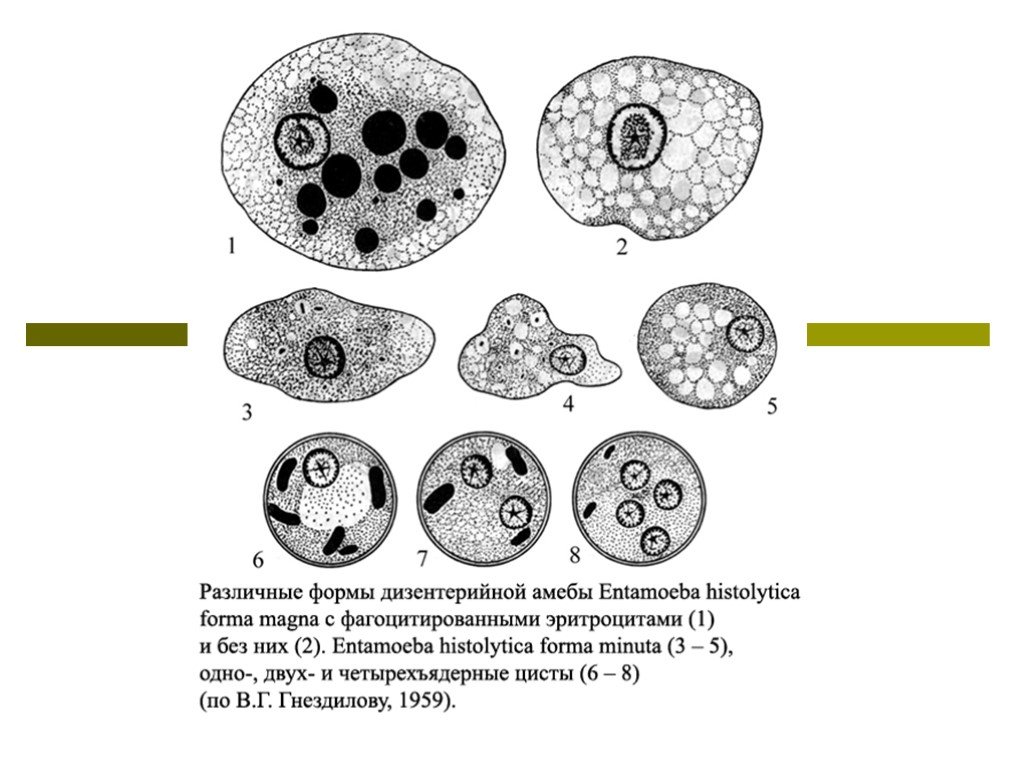
Treatment of amoebiasis
The most effective drugs for the destruction of pathogens are metronidazole and tinidazole. They are prescribed in a course of 3 to 8 days.
Amoebiasis treatment includes additional antimicrobials (intestopan, tetracyclines), drugs to eliminate diarrhea, bloating, enterosorbents, vitamins. When abscesses form, they need surgical treatment.
In the case of the cutaneous form, metronidazole preparations in the form of a cream are additionally prescribed.
With timely treatment, the prognosis for this disease is favorable. Life-threatening are late diagnosed liver or lung abscesses.
Prophylaxis
No vaccine has been developed against the pathogen. Prevention of amebiasis includes the following measures:
- hospitalization and isolation of patients, their treatment until the pathogens disappear in the feces;
- identification and treatment of disease carriers;
- prohibition for persons who have had amoebiasis to work in catering establishments;
- careful observance of personal hygiene, drinking only boiled water, especially when staying in countries with a hot climate;
- during tourist trips to dangerous areas, do not eat vegetables and fruits that have already been washed by someone, wash them thoroughly before use, use a straw to drink from water bottles, do not drink drinks with ice or carbonated drinks, do not eat milk, cheese, etc.
 unpasteurized foods, do not buy food on the street.
unpasteurized foods, do not buy food on the street.
Amoebiasis should not be self-treated. When the first signs of the disease appear, you should consult a doctor.
Treatment of amebiasis in the clinic “Mama Papa Ya”
Mama Papa Ya family clinic network provides medical services for suspected amoebiasis. If loose stools appear, pain in the right side of the abdomen, especially after returning from a vacation from warm countries, we recommend contacting a pediatrician, therapist or gastroenterologist.
Advantages of our clinic:
- branch network located in Moscow and other cities;
- quick reception of a specialist without queues;
- good training of physicians and extensive experience to suggest the correct diagnosis clinically;
- confirmation of the diagnosis is carried out by laboratory tests using modern equipment, which eliminates the possibility of error;
- prescribing modern drugs for the treatment of amebiasis in children and adults and monitoring the effectiveness of therapy when the patient refuses to be hospitalized in an infectious diseases hospital.

The doctors of our clinic specialize in such diseases, you can make an appointment right now!
Reviews
Good clinic, good doctor! Raisa Vasilievna can clearly and easily explain what the essence of the problem is. If something is wrong, she talks about everything directly, not in a veiled way, as other doctors sometimes do. I don’t regret that I went to her.
Anna
I would like to thank the staff of the clinic Mom, Dad, me. The clinic has a very friendly atmosphere, very friendly and cheerful staff and highly qualified specialists. Thank you very much! I wish prosperity to your clinic.
Anonymous user
Today I removed a mole on my face at the dermatologist Kodareva I.A. Doctor is very thorough! Correct! Thanks a lot! Administrator Borshchevskaya Julia is friendly, clearly fulfills her duties.
Belova E.M.
Today I was served in the clinic, I was satisfied with the staff, as well as the gynecologist. Everyone treats patients with respect and care. We thank them very much and continue to prosper.
We thank them very much and continue to prosper.
Anonymous
The Mama Papa Ya clinic in Lyubertsy is very good. The team is friendly and responsive. I recommend this clinic to all my friends. Thanks to all doctors and administrators. I wish the clinic prosperity and many adequate clients.
Iratiev V.V.
Visited the clinic “Mama Papa Ya” with a child. I needed a consultation with a pediatric cardiologist. I liked the clinic. Good service doctors. We didn’t stand in line, everything was the same price.
Evgeniya
I liked the first visit. I was carefully examined, additional examinations were prescribed, and good recommendations were given. I will continue the treatment further, I liked the conditions in the clinic.
Kristina
The doctor carefully examined my husband, ordered an ECG and made a preliminary diagnosis. She made recommendations about our situation and ordered additional examinations. So far, there are no comments.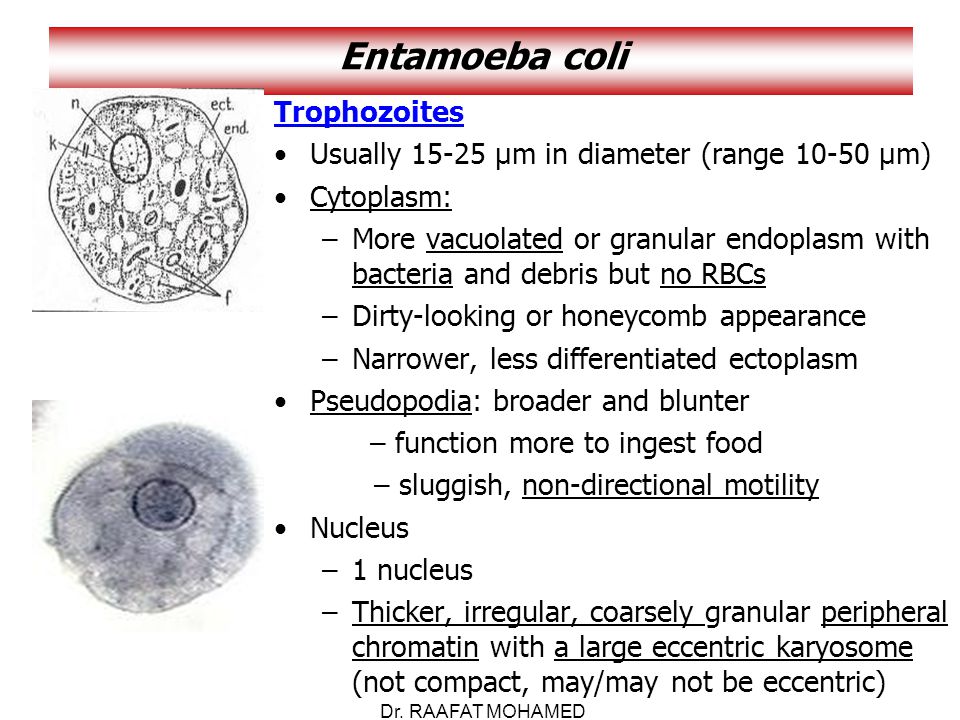




 Curr Clin Microbiol Rep. 2019;6(1):51-57. [PMC free article: PMC6449278] [PubMed: 31008019]
Curr Clin Microbiol Rep. 2019;6(1):51-57. [PMC free article: PMC6449278] [PubMed: 31008019]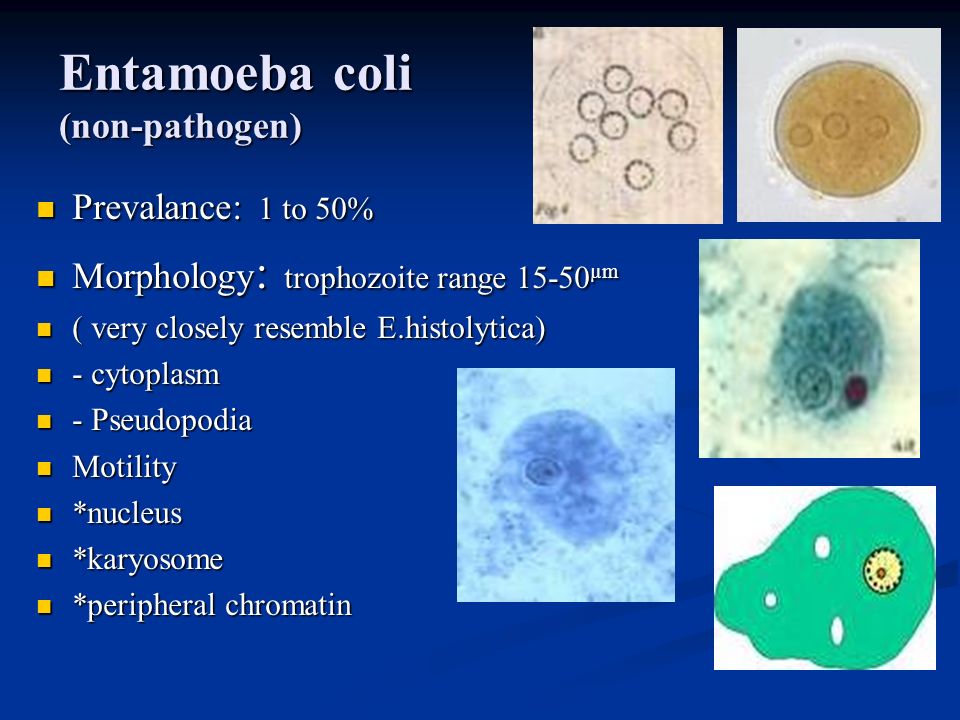 PLoS Negl Trop Dis. 2016 May;10(5):e0004697. [PMC free article: PMC4859568] [PubMed: 27152855]
PLoS Negl Trop Dis. 2016 May;10(5):e0004697. [PMC free article: PMC4859568] [PubMed: 27152855] [PMC free article: PMC4958447] [PubMed: 27478673]
[PMC free article: PMC4958447] [PubMed: 27478673]



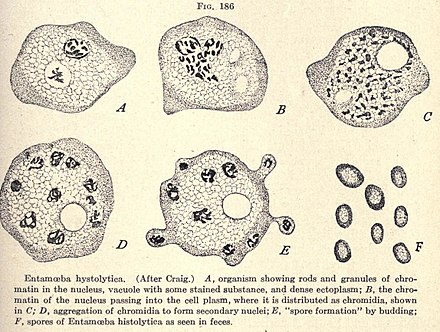 Curr Clin Microbiol Rep. 2019;6(1):51-57. [PMC free article: PMC6449278] [PubMed: 31008019]
Curr Clin Microbiol Rep. 2019;6(1):51-57. [PMC free article: PMC6449278] [PubMed: 31008019]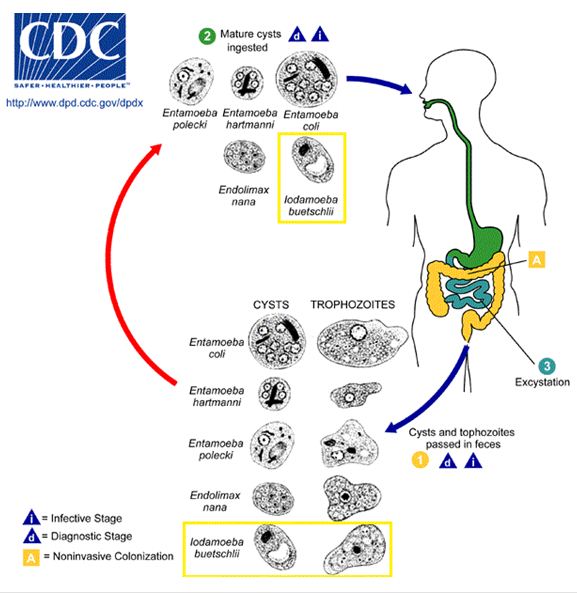 PLoS Negl Trop Dis. 2016 May;10(5):e0004697. [PMC free article: PMC4859568] [PubMed: 27152855]
PLoS Negl Trop Dis. 2016 May;10(5):e0004697. [PMC free article: PMC4859568] [PubMed: 27152855] [PMC free article: PMC4958447] [PubMed: 27478673]
[PMC free article: PMC4958447] [PubMed: 27478673]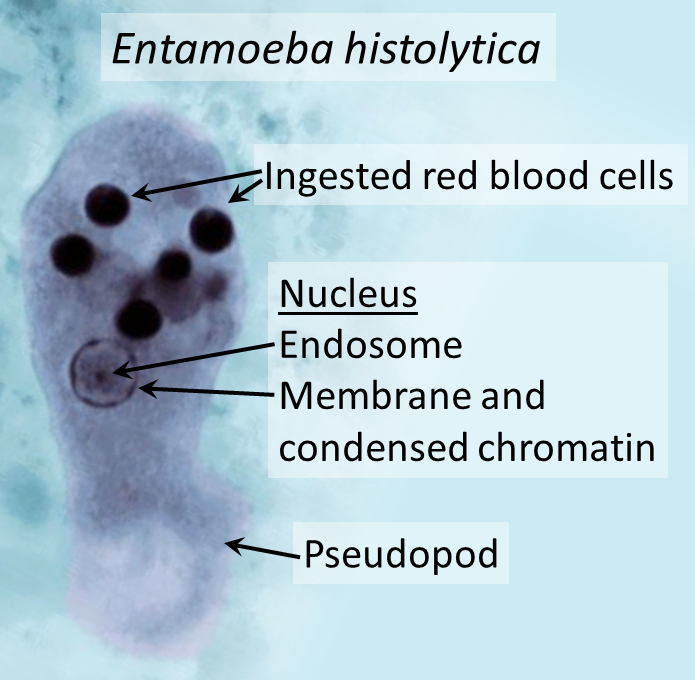
 unpasteurized foods, do not buy food on the street.
unpasteurized foods, do not buy food on the street.